
06
Jan
(Beyond Pesticides, January 6, 2016) Last month, the U.S. Environmental Protection Agency (EPA) published its final rule to clarify the substances on the minimum risk pesticide ingredient list, also known as the Federal Insecticide, Fungicide, and Rodenticide Act (FIFRA) Section 25(b) List, and revise the way these ingredients are identified on product labels. The new rule require manufacturers to  more clearly disclose to  state agencies, companies, and the general public the  chemical ingredients contained in the 25(b) products. EPA hopes that this will ultimately improve compliance and enforcement.
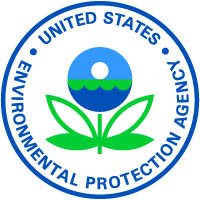 Minimum risk pesticides, or  25(b) pesticides, are a special class of pesticides that are not required to be registered with EPA because their ingredients, both active and inert, are considered nonhazardous  to human health or the environment. They include commonly known botanicals and plants compounds such as cedarwood oil, citronella, corn meal gluten, peppermint oil, sodium chloride and white pepper that can be used for their pesticidal properties. Manufactures of these  products are required to fully disclose their ingredient list  on product labels, which Beyond Pesticides has long championed for all pesticide products. Currently, so-called inert ingredients, which EPA considers proprietary information and make up the majority of product ingredients in many pesticides, are not disclosed on pesticide product labels. However, there has been a lack of clarity on minimum risk pesticide product labels in the past that  has made it difficult for enforcement officials to ensure compliance with the 25(b) criteria, given that the manufacturer uses its own judgment on whether the product meets the exemption requirements.
Minimum risk pesticides, or  25(b) pesticides, are a special class of pesticides that are not required to be registered with EPA because their ingredients, both active and inert, are considered nonhazardous  to human health or the environment. They include commonly known botanicals and plants compounds such as cedarwood oil, citronella, corn meal gluten, peppermint oil, sodium chloride and white pepper that can be used for their pesticidal properties. Manufactures of these  products are required to fully disclose their ingredient list  on product labels, which Beyond Pesticides has long championed for all pesticide products. Currently, so-called inert ingredients, which EPA considers proprietary information and make up the majority of product ingredients in many pesticides, are not disclosed on pesticide product labels. However, there has been a lack of clarity on minimum risk pesticide product labels in the past that  has made it difficult for enforcement officials to ensure compliance with the 25(b) criteria, given that the manufacturer uses its own judgment on whether the product meets the exemption requirements.
The revisions to the minimum risk pesticide list, Â announced on December 28, 2015, do not alter the substance of the minimum risk pesticide ingredient lists, according to EPA, but more accurately describe which chemical substances can be used in pesticide products that are exempt from federal pesticide registration requirements. The rule reorganizes the ingredient list (40 CFR 125.25) and adds specific chemical identifiers (CAS numbers) to make clearer the specific ingredients that are permitted in minimum risk pesticide products. This will assist in improving compliance and enforcement oversight of these pesticide products and harmonize labels across manufacturers. EPA is also requiring producer contact information and the use of specific common chemical names in lists of ingredients on minimum risk pesticide product labels.
Further, there have been many producers claiming the 25(b) exemption and market their products as minimum risk while having “inert” ingredients that are not permitted under the exemption criteria. EPA is therefore also codifying the list of “inert” ingredients allowed to be used in these products. The list  can be found here. These “inert” ingredients were historically categorized  as List 4A under 40 CFR 180.950. However, the list is no longer updated by EPA, but maintained as a resource to partially  define the  substances that are  acceptable under organic standards. EPA does not allow in minimum risk 25(b) pesticides inerts previously listed as 4B, which are more toxic materials and currently allowed in organic production. [Note that the National Organic Standards Board (NOSB) recommended to USDA in 2010 and 2012 that it review all the inerts currently allowed in organic over a five-year period, but has not undertaken a thorough review as the NOSB had intended, so 4B inerts are currently allowed in organic. Beyond Pesticides is working to hold USDA accountable to this NOSB recommendation. See comments. EPA believes that having an  inert ingredient list directly in the regulations offers much needed clarity to what is allowed, and  will improve the efficiency of inspections because inspectors will not have to look through multiple sources to find the necessary ingredient list. Codifying this inert ingredient list will  also make it easier for producers, whether chemical or organic, that use 25(b) products to identify all ingredients, including inert.
Consumers are becoming increasingly wary of products with toxic ingredients, driving a huge shift towards ”˜greener’ technologies. Many credit  the minimum risk exemption to be a major driver of ”˜greener,’ least-toxic product alternatives for pest management, with sales increasing annually. Growing brands such as EcoSmart and CedarCide have created least-toxic pesticide products that are enjoying great commercial success, with many of their products under section 25(b) status. This, coupled with a growing organic market, offers opportunities and challenges for formulators to develop and market least-toxic products with minimum risk pesticides that may be compatible with low hazard standards, such as organic, and consumer expectations.
For more on minimum risks pesticides http://www.epa.gov/minimum-risk-pesticides
All unattributed positions and opinions in this piece are those of Beyond Pesticides.
Source: EPA
Posted in Announcements, Chemicals, Pesticide Regulation by: Beyond Pesticides
No Comments
05
Jan
(Beyond Pesticides, January 5, 2016) An administrative court judge has agreed to hear a case filed by a U.S. Department of Agriculture (USDA) pollinator researcher who says his  firing by the agency  was retaliation for his  cutting edge research  linking neonicotinoid insecticides to declinining monarch butterfly populations, which  has drawn  national attention and international recognition. Late last year, Judge Patricia M. Miller of the Merit Systems Protection Board denied USDA’s request to dismiss a claim filed  by Johnathan Lundgren, PhD, a USDA employee for eleven years with high accolades.
 In April of last year, Dr. Lundgren published a study in The Science of Nature (pdf) that shows that clothianidin, a neonicotinoid insecticide  often used to coat seeds, kills monarch butterfly larvae in the laboratory. On August 3, 2015, USDA imposed a 14-day suspension against Dr. Lundgren for submitting the study and for a paperwork error in his travel authorization for his invited presentation about his research to a panel of the National Academy of Sciences, as well as to a USDA stakeholder group, the Pennsylvania No-Till Alliance. The suspension was cut to 14 days from 30 after Dr. Lundgren filed an appeal.
In April of last year, Dr. Lundgren published a study in The Science of Nature (pdf) that shows that clothianidin, a neonicotinoid insecticide  often used to coat seeds, kills monarch butterfly larvae in the laboratory. On August 3, 2015, USDA imposed a 14-day suspension against Dr. Lundgren for submitting the study and for a paperwork error in his travel authorization for his invited presentation about his research to a panel of the National Academy of Sciences, as well as to a USDA stakeholder group, the Pennsylvania No-Till Alliance. The suspension was cut to 14 days from 30 after Dr. Lundgren filed an appeal.
In October 2015, Dr. Lundgren, respresented by Public Employees for Environmental Responsibility (PEER), filed a whistleblower complaint against USDA, claiming it “gave no substantive reason” for denying Dr. Lundgren’s travel request and made “repeated attempts”¦to impede or deter his research and resultant publications.” Dr. Lundgren’s research on the harm neonicotinoids pose to monarch butterflies reflects a growing scientific consensus that these chemicals present significant risks to declining pollinator populations. However, as stated in the complaint, despite receiving approval for the paper through proper protocols, higher-ups at USDA deemed the research “sensitive,” and claimed that Dr. Lundgren had not received approval to publish the study.
Judge Miller’s ruling is a strong rebuke to an agency that asserted Dr. Lundgren’s complaint was “frivolous” and based on information that was “speculative and unsupported.” USDA and Dr. Lundgren were ordered by the court to convene a status conference on January 6, 2016, to discuss a potential settlement, according to the Washington Post. “We were very pleased to receive Judge Miller’s ruling,” said Laura Dumais, the PEER attorney representing Lundgren to the Washington Post, “as we feel Dr. Jonathan Lundgren has a very strong case.”
In April 2015, PEER filed a petition for rulemaking with USDA, urging the agency to strengthen its Scientific Integrity Policy and adopt best practices used in other federal agencies in order to prevent politicized suppression or alteration of studies. The group claims that at least 10 USDA scientists have been investigated or have faced other consequences as a result of research questioning the safety of certain pesticides. The current policy disallows scientists from “making statements that could be construed as being judgments of or recommendations on USDA or any other federal policy, either intentionally or inadvertently.”
“The job of a government scientist is to conduct research to help guide policy,” said PEER attorney Laura Dumais to the Washington Post, “so prohibiting them from saying anything that could even be ”˜construed’ as commenting on policy essentially gives supervisors the right to punish anyone they want, for giving any interview at all. Dr. Jonathan Lundgren’s case is a textbook example of that.”
With science both in and outside of the U.S. pointing to a growing list of impacts from pesticides and genetically engineered (GE) crops, ranging from the decline of bees to the carcinogenicity of the widely used herbicide glyphosate, it is critical that federal scientific agency staff tasked with protecting human and environmental health are able to inform the public without repercussions.
Help us defend independent science by signing this petition to USDA today!
Dr. Lundgren will join Beyond Pesticides for a presentation at the 34th National Pesticide Forum in Portland, ME on April 15-16, 2016. The conference brings together top scientists, policy makers, and public health and environmental advocates to interact, engage in dialogue, and strategize on solutions that are protective of health and the environment. Aaron Blair, PhD, chair at the International Agency for Research on Cancer, another target of chemical industry pressure after a finding that glyphosate is carcinogenic based on laboratory animal studies, will also speak at the Forum.
Reserve your spot today to receive the Early Bird Discount rate ($5 off)! For more information and to purchase tickets, see this webpage.
All unattributed positions and opinions in this piece are those of Beyond Pesticides.
Source: Washington Post
Posted in Announcements, Chemicals, Litigation, National Politics, neonicotinoids, Pollinators by: Beyond Pesticides
1 Comment
04
Jan
(Beyond Pesticides, January 4, 2016) A study published by the U.S. Geological Survey (USGS) and U.S. Fish and Wildlife Service (FWS) found large-scale evidence of intersex in smallmouth and largemouth bass in the Northeast United States, an indicator of endocrine disruption. The study, published in the journal Ecotoxicology and Environmental Safety, looks at 19 U.S. National Wildlife Refuges and is the first reconnaissance survey of this scope. The study found that the prevalence of testicular oocytes across all samples was 85% and 27% for male small- and largemouth bass, respectively.
 Intersex occurs when one sex develops characteristics of the opposite sex. In the case of this study, researchers found testicular oocytes ””female eggs found inside male testicles””in male smallmouth and largemouth bass. The
Intersex occurs when one sex develops characteristics of the opposite sex. In the case of this study, researchers found testicular oocytes ””female eggs found inside male testicles””in male smallmouth and largemouth bass. The
study explains, “The presence of oocytes in the testes of male gonochoristic fish has been used as an indicator of estrogenic exposure.” The source of the estrogen is hard to pinpoint, but pesticides are often cited as a cause given that they widely pollute waterways that  fish populate. Those chemicals have properties that disrupt the endocrine system and affect the reproductive system, causing development issues such as testicular oocytes. According to USGS, “Intersex is a global issue, as wild-caught fish affected by endocrine-disrupting chemicals have been found in locations across the world.”
According to the USGS press release for the study, “Estrogenic endocrine-disrupting chemicals are derived from a variety of sources, from natural estrogens to synthetic pharmaceuticals and agrochemicals that enter the waterways. Examples include some types of birth control pills, natural sex hormones in livestock manures, herbicides and pesticides.”
While the study did not look for the sources of endocrine disruption, it did paint a picture of how widespread this abnormality really is, encouraging management actions to combat runoff. “It is not clear what the specific cause of intersex is in these fish,” said Luke Iwanowicz, a USGS research biologist and lead author of the paper, in their press release. “This study was designed to identify locations that may warrant further investigation.  Chemical analyses of fish or water samples at collection sites were not conducted, so we cannot attribute the observation of intersex to specific, known estrogenic endocrine-disrupting chemicals.”
Last summer, Â research by the U.S. Geological Survey (USGS) Â showed a strong correlation between the occurrence of intersex characteristics on fish, which have been found in the Chesapeake Bay region, and areas of high agricultural use in Pennsylvania. Â In addition, a recent report by the Pennsylvania Department of Environmental Protection (DEP) found rare malignant tumors on smallmouth bass in the Susquehanna River, a river that flows through the northeast from upstate New York to the Chesapeake Bay. The Susquehanna River is a major source of agricultural runoff containing phosphorous, nitrogen, and sediment pollutants, as well as natural animal hormones in manure. Pennsylvania DEP officials are looking to in-depth studies to identify the sources of the endocrine-disrupting compounds and herbicides likely contributing to the tumors.
This is a step that USGS would like to see taken as well. The study states, “A comprehensive re-evaluation that includes chemical analysis and seasonal snapshots of both sites is necessary to identify the likely cause(s) of elevated plasma vitellogenin in these male smallmouth bass.”
In addition to the Pennsylvania DEP study, other scientists are examining fish as a means of gauging water quality and chemical exposure. In 2008, USGS identified ten contaminants, including atrazine, chlorpyrifos, and endosulfan, responsible for intersex fish in the Potomac River. Atrazine, one of the most commonly used herbicides in the world, has been shown to affect reproduction of fish at concentrations below U.S. Environmental Protection Agency’s (EPA) water-quality guidelines. A November study found that commonly-used pesticides can persist in and impact the species of a waterway long after the chemicals are detectable or monitored by regulators.
Beyond Pesticides continues to fight to  prevent water pollution and harmful agricultural practices. Visit our  Threatened Waters  page and learn how organic land management practices contribute to healthy waters in the article, “Organic Land Management and the Protection of Water Quality.”
All unattributed positions and opinions in this piece are those of Beyond Pesticides.
Source: Â U.S. Geological Survey
Posted in Announcements, Antibacterial, Disease/Health Effects, Endocrine Disruption, Pesticide Residues, Take Action, Water, Wildlife/Endangered Sp. by: Beyond Pesticides
No Comments
24
Dec
(Beyond Pesticides, December 24, 2015) Beyond Pesticides would like to thank our members and supporters for making 2015 a year of historic victories in advancing sustainable and organic land and building management. As our Daily News takes a holiday break, returning Monday, January 4, 2016, we hope you will join us in reflecting on the progress made this year, and the challenges that still lie ahead.
As members and supporters of Beyond Pesticides, we know you share the same sense of momentum and accomplishment that the staff and board feel at the close of 2015. We would like to deeply thank you for aligning with Beyond Pesticides’ mission, whether through talking to friends and coworkers about pesticide concerns, work in your local community, defending organic through public comments, joining us at our 33rd National Pesticide Conference, signing important petitions, or supporting our numerous other program areas. We look forward to working with you to grow our voice in 2016, and reach more individuals, local and state governments, and businesses with the knowledge and technical expertise that will support a transition in pest management practices that no longer utilize toxic products and adopt a sustainable and organic approach. Your tax-deductible year-end donation will continue to fuel this positive change into 2016.
Local Policy Victories
In a watershed moment for the movement against toxic pesticide use, Montgomery County, Maryland successfully passed the strongest restrictions on public and private cosmetic pesticide use in the United States, expanding upon the trail blazed by Takoma Park, MD in 2013, and Ogunquit, ME in 2014. The absence of regressive state-level preemption laws enabled these communities to extend their policies to restrict toxic pesticide use on private property.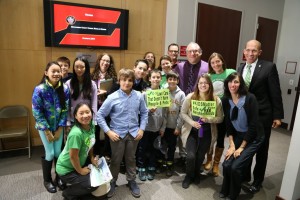
However, even in communities subject to state-level preemption, local governments made tremendous strides towards protecting the health of their residents, pollinators, water quality, and the wider environment. A long list of new pollinator protective policies were passed throughout the country, from Boulder, Boulder County and Layfayette, CO, to Thurston County, WA, to Plattsburg, NY, to Portland, OR and Minneapolis, MN. Minneapolis’ resolution stands out as it aimed to encompass the holistic changes in pest management practices necessary to truly protect pollinators and public health by moving the city not only towards becoming neonicotinoid-free (the insecticides linked to pollinator decline), but also organic on its public spaces. Reno, Nevada is also working in this direction, officially approving a pesticide-free parks program aimed at improving the health of its residents and local environment.
And at the state level, Connecticut’s move to expand its forward-thinking restrictions on pesticide use on school playing fields to all playgrounds in the state highlights the imminent threat unnecessary pesticide use poses to children, who are uniquely susceptible to their impacts.
>>Help us continue to build momentum towards comprehensive pesticide restrictions in your community by Signing Your Support for a Pesticide-Free Community.
Changing the Marketplace
 As more and more communities transition to pollinator-friendly and organic pest management practices, it is critical that home and garden retailers support and facilitate these changes by phasing out and eventually eliminating their stock of toxic products. Beyond Pesticides’ Making the Switch video highlights Eldredge Lumber and Hardware in York, Maine, which is supporting Ogunquit’s organic pesticide policy by enabling its customers to reorient their approach to pest control. To help other hardware stores replicate this forward-thinking and financially sound approach, we also crafted a resource for new products and practices through The Well-Stocked Hardware Store. Â
As more and more communities transition to pollinator-friendly and organic pest management practices, it is critical that home and garden retailers support and facilitate these changes by phasing out and eventually eliminating their stock of toxic products. Beyond Pesticides’ Making the Switch video highlights Eldredge Lumber and Hardware in York, Maine, which is supporting Ogunquit’s organic pesticide policy by enabling its customers to reorient their approach to pest control. To help other hardware stores replicate this forward-thinking and financially sound approach, we also crafted a resource for new products and practices through The Well-Stocked Hardware Store. Â
 And slowly but surely, big-box retailers are beginning to take this line of responsible action. In April, Lowe’s announced it would phase-out the sale of neonicotinoids and neonic-coated plants by 2018, and move towards stocking more organic alternatives in its stores. In December, after making a commitment to labeling plants pre-treated with neonics, Home Depot announced it was following Lowe’s in phasing out these bee-toxic products. True Value and ACE’s corporate headquarters still need to feel the heat; help us urge them to Act Now!
And slowly but surely, big-box retailers are beginning to take this line of responsible action. In April, Lowe’s announced it would phase-out the sale of neonicotinoids and neonic-coated plants by 2018, and move towards stocking more organic alternatives in its stores. In December, after making a commitment to labeling plants pre-treated with neonics, Home Depot announced it was following Lowe’s in phasing out these bee-toxic products. True Value and ACE’s corporate headquarters still need to feel the heat; help us urge them to Act Now!
Rejecting Chemical-Dependent Agriculture by Promoting and Defending Organic
Beyond Pesticides continues to celebrate the growth of organic agriculture as the only viable, economical alternative, which is verifiable, to chemically dependent cropping systems. Our strategic victories in moving organic agriculture forward are part of a twofold strategy. First, we work to highlight and reject the deficiencies in conventional and genetically engineered (GE) agriculture, which relies on the ever increasing use of new and more toxic pesticides which is advanced by Monsanto and Dow AgroSciences. In a lawsuit filed with health and environmental allies we successfully challenged the U.S. Environmental Protection Agency’s approval of Enlist Duo, a toxic cocktail of carcinogenic glyphosate and 2,4-D on the basis of untested synergistic impacts. Second, we fight to defend the integrity built into the organic label by decades of dedicated advocates and policymakers. In September, we successfully fended off a motion to dismiss a legal challenge against a USDA rule allowing the contamination of organic compost with toxic synthetic pesticides.
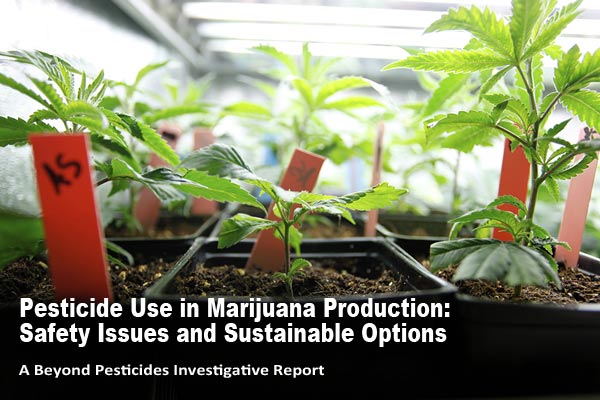 Our efforts to defend organic aren’t limited to traditional crops. As more and more states allow medical and legal cannabis, Beyond Pesticides is working to orient the budding industry on a sustainable, organic trajectory. After public testimony and letters to the Governor of Colorado on the dangers of pesticides use on marijuana, an executive order declared pesticide-tainted cannabis “a threat to public safety,” and subject to quarantine.
Our efforts to defend organic aren’t limited to traditional crops. As more and more states allow medical and legal cannabis, Beyond Pesticides is working to orient the budding industry on a sustainable, organic trajectory. After public testimony and letters to the Governor of Colorado on the dangers of pesticides use on marijuana, an executive order declared pesticide-tainted cannabis “a threat to public safety,” and subject to quarantine.
>>Please continue to support our efforts to defend the organic label by going to Save Our Organic, and providing a public comments when it comes time for the spring National Organic Standards Board meeting.
Promoting Sound Science on Pesticide Hazards
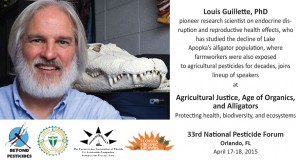 Underlining all of our victories is the work performed by the dedicated independent scientists whose studies point to hazards not analyzed or simply not considered under the EPA’s current pesticide regulatory framework. At the 33rd National Pesticide Forum this year, keynote speakers Tyrone Hayes, PhD, and Lou Guillette, PhD (skip to time stamp: 20:31) presented their latest research on endocrine disrupting chemicals and their impact to wildlife. The environmental community continues to mourn the loss of Dr. Guillette. There is no denying the incredible importance his magisterial studies on Lake Apopka alligators contributed to our understanding of pesticide hazards.
Underlining all of our victories is the work performed by the dedicated independent scientists whose studies point to hazards not analyzed or simply not considered under the EPA’s current pesticide regulatory framework. At the 33rd National Pesticide Forum this year, keynote speakers Tyrone Hayes, PhD, and Lou Guillette, PhD (skip to time stamp: 20:31) presented their latest research on endocrine disrupting chemicals and their impact to wildlife. The environmental community continues to mourn the loss of Dr. Guillette. There is no denying the incredible importance his magisterial studies on Lake Apopka alligators contributed to our understanding of pesticide hazards.
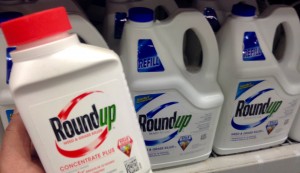 Sound, independent science is continuously under attack from the pesticide industry. Soon after an international panel of researchers under the World Health Organization’s International Agency for Research on Cancer determined that glyphosate was carcinogenic based on studies in laboratory animals, Monsanto and other chemical companies launched attacks against the agency, eventually going as far as convening its own panel of “experts,” in a failed attempt to show the safety of its flagship product. Aaron Blair, PhD, a National Cancer Institute researcher (retired), chair of the International Agency for Research on Cancer’s (IARC) evaluation panel that found  glyphosate (Roundup) to be a carcinogen will be speaking at Beyond Pesticides’ 34th National Pesticide Forum in Portland, Maine in April 2016.
Sound, independent science is continuously under attack from the pesticide industry. Soon after an international panel of researchers under the World Health Organization’s International Agency for Research on Cancer determined that glyphosate was carcinogenic based on studies in laboratory animals, Monsanto and other chemical companies launched attacks against the agency, eventually going as far as convening its own panel of “experts,” in a failed attempt to show the safety of its flagship product. Aaron Blair, PhD, a National Cancer Institute researcher (retired), chair of the International Agency for Research on Cancer’s (IARC) evaluation panel that found  glyphosate (Roundup) to be a carcinogen will be speaking at Beyond Pesticides’ 34th National Pesticide Forum in Portland, Maine in April 2016.
Bayer and Syngenta, the major manufactures of neonicotinoid insecticides continue to dismiss independent science linking their products to pollinator declines. Despite a large and continuously growing body of research, and an acknowledgement from the White House that these long-lived systemic chemicals cause harm to bees, these companies continue reap enormous profits while beekeepers and our food supply suffers. And they use their influence in the government to attack scientists that threaten these profits. Jonathan Lundgren, PhD, filed a whistleblower complaint against the USDA for unprofessional retaliation following the publication of a study linking neonicotinoid insecticides to the decline of monarch butterflies. Yet in the face of such persecution, the Beyond Pesticides and the environmental community will continue to rise of in defense of independent scientists. In late 2015, Dr. Lundgren was awarded the Joe A. Callaway Award for Civic Courage, intended to honor those who “at some personal risk, take a public stance to advance truth and justice, and who challenge prevailing conditions in pursuit of the common good.” We look forward to hearing Dr. Lundgren speak at our 34th National Pesticide Forum.
>>Help us help independent scientists by signing this petition against USDA’s industry-influenced retaliatory tactics.
 Happy Holidays and New Year
Happy Holidays and New Year
Our victories must be continuously defended from the chemical and pesticide industry. As we celebrate state and local victories, we must continue to push for more while making ourselves aware of intentions to roll them back through undemocratic preemption language in these states. As we cheer marketplace changes, we must understand that faster progress and broader changes are necessary from stores both large and small. And as we work against chemical dependent agriculture and promote organic, we must also be ready to defend the certification system from an industry that wishes to weaken its meaning while maintaining the premium prices organic food demands.
Thank you again for joining with us together this year to make these victories happen. We hope you’ll take some time this holiday season to celebrate these accomplishments, and come together with us next year, refreshed, and ready for the new challenges, and new victories that lie ahead.
Best wishes for the New Year!

Posted in Agriculture, Alternatives/Organics, Announcements, Environmental Justice, Events, Genetic Engineering, Take Action by: Beyond Pesticides
No Comments
23
Dec
(Beyond Pesticides, December 23, 2015) Native  bees are on the decline in some of the major agricultural regions in the United States, according to a new study. The study scientists produced the first national map of bee populations and identified numerous trouble areas. Since 2006, honey bees and other pollinators in the U.S. and throughout the world have experienced ongoing and rapid population declines. The continuation of this crisis threatens the stability of ecosystems, the economy, and food supply, as one in three bites of food are dependent on pollinator services.
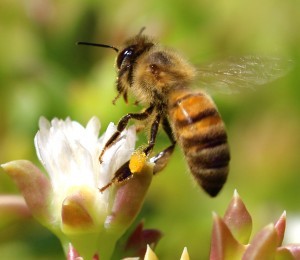 The study, titled Modeling the status, trends, and impacts of wild bee abundance in the United States  and published in the journal Proceedings of the Natural Academy of Science, for the first time aims to assess the status and trends of wild bees and their potential impacts on pollination services across the U.S. and found that between 2008 and 2013 bee abundance declined across 23% of the nation’s  land area. The decline is generally associated with conversion of natural habitats to row crops. The researchers also list pesticide use, climate change, and disease as other threats to wild bees. The researchers specifically cited 139 counties as especially worrisome, with wild bee numbers decreasing while farmland for crops dependent on such pollinators is increasing. The counties include agricultural regions of California such as the Central Valley, as well as the Pacific Northwest, the upper Midwest and Great Plains, west Texas and the southern Mississippi river valley.
The study, titled Modeling the status, trends, and impacts of wild bee abundance in the United States  and published in the journal Proceedings of the Natural Academy of Science, for the first time aims to assess the status and trends of wild bees and their potential impacts on pollination services across the U.S. and found that between 2008 and 2013 bee abundance declined across 23% of the nation’s  land area. The decline is generally associated with conversion of natural habitats to row crops. The researchers also list pesticide use, climate change, and disease as other threats to wild bees. The researchers specifically cited 139 counties as especially worrisome, with wild bee numbers decreasing while farmland for crops dependent on such pollinators is increasing. The counties include agricultural regions of California such as the Central Valley, as well as the Pacific Northwest, the upper Midwest and Great Plains, west Texas and the southern Mississippi river valley.
Earlier this year, researchers at Cornell University found that as the use of pesticides on apple orchards in New York State  increased, the abundance of wild bees declined significantly. The researchers  analyzed wild bee populations on 19 apples orchards across the state of New York between 2011 and 2012. Data was broken down by class of pesticide (fungicide, insecticide, herbicides), and timing of applications (before, during, and after flower bloom). Researchers also analyzed the percentage of natural areas within the surrounding landscape.  Wild bee numbers declined significantly as pesticide use increased, but the overall impact of pesticides on wild bees was found to be highest in generations following pesticide exposure, indicating that pesticides affect bee reproduction or offspring. Further, researchers found that fungicides, widely regarded as having low toxicity to bees, had a measurable impact on wild bee abundance. “High and repeated exposure was the likely explanation” for this finding, according to the study.  Fungicide applications prior to apple flower blooming resulted in the steepest decline in wild bee abundance and diversity. This result indicates that wild bees are visiting orchards before apple trees begin to bloom. Further, researchers found insecticide applications affected  bees the mostly  after bloom occurred. The authors explain that, while honey bees are placed in orchards for a short time during bloom, wild bees are more frequently exposed to chemical pesticides because they continue to forage in and around apple orchards before and after the bloom period.
In this latest study, the counties grew crops such as almonds, pumpkins, squashes, blueberries, watermelons, peaches and apples that are highly dependent on pollinators, or had large amounts of less-pollinator-dependent crops including soybeans, canola and cotton.
According to US News, Taylor Ricketts, Ph.D., director of the University of Vermont’s Gund Institute for Ecological Economics, said the 139 counties represent 39% of the pollinator-dependent crop area of the United States and most likely will face inadequate pollination in the future. “Wild bee declines may increase costs for farmers and, over time, could even destabilize crop production,” Dr. Ricketts said.
Their decline may prompt greater dependence on commercial honeybee colonies for pollinating crops, but honeybee numbers also are falling, added Gund Institute researcher Insu Koh, PhD, the lead author of the study.
“Our results highlight the need for strategies to maintain pollinator populations in farmland, and the importance of conservation programs that provide flowering habitat that can support wild bees and other pollinators,” said Michigan State University entomologist Rufus Isaacs, who heads the U.S. Department of Agriculture-funded Integrated Crop Pollination Project.
The study follows a 2014 memorandum by Barack Obama creating a task force to study pollinator losses. The task force in May called for preserving wide swathes of pollinator habitats, yet falls short of recommendations submitted by Beyond Pesticides, beekeepers, and others who stress that pollinator protection begins with strong regulatory action and suspension of bee-toxic pesticides.
The  Saving America’s Pollinator’s Act of 2015  remains an avenue for Congress to address the pollinator crisis.  Contact your U.S. Representative  and ask them to support this important legislation today. You can also get active in your community to protect bees by advocating for policies that restrict their use. Montgomery County, Maryland recently  restricted the use of a wide range of pesticides, including neonicotinoids, on public and private property.  Sign here  if you’d like to see your community do the same!
Sources: US News, PNAS
All unattributed positions and opinions in this piece are those of Beyond Pesticides
Posted in Announcements, Habitat Protection, Increased Vulnerability to Diseases from Chemical Exposure, Persistence, Pollinators, Take Action, Wildlife/Endangered Sp. by: Beyond Pesticides
No Comments
22
Dec
(Beyond Pesticides, December 22, 2015) Beyond Pesticides is pleased to announce the 34th National Pesticide Forum, which will be held April 15th-16th, 2016 at the University of Southern Maine, in Portland, ME. Leading scientists on  the lineup of speakers for the upcoming forum include: Aaron Blair, Ph.D., a National Cancer Institute researcher (retired), author of more than 450 publications on occupational and environmental causes of cancer,  and the overall chair  the International Agency for Research on Cancer’s (IARC) evaluation panel that found  glyphosate (Roundup) to be a carcinogen; and Jonathan Lundgren, Ph.D., a top U.S. Department of Agriculture (USDA) entomologist who received a prestigious national award for civic courage  (Entomologist in the Crosshairs of Science  and Corporate Politics) for his work on neonicotinoids and pollinator decline in the face of agency attempts to suppress his work.
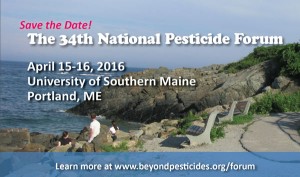 Beyond Pesticides is collaborating with local groups, including the Maine Organic Farmers and Gardeners Association (MOFGA), Toxics Action Center, and Protect South Portland, as well as other local environmental and human health advocacy organizations. The 34th National Forum provides an opportunity for grassroots advocates, scientists, and policy makers to share our efforts and build local, state and national strategies for strength and growth. This year’s conference will focus on the adoption of policies to protect human health and the environment, and organic land and building management strategies. The conference brings together top scientists, policy makers, and public health and environmental advocates to interact, engage in dialogue, and strategize on solutions that are protective of health and the environment.
Beyond Pesticides is collaborating with local groups, including the Maine Organic Farmers and Gardeners Association (MOFGA), Toxics Action Center, and Protect South Portland, as well as other local environmental and human health advocacy organizations. The 34th National Forum provides an opportunity for grassroots advocates, scientists, and policy makers to share our efforts and build local, state and national strategies for strength and growth. This year’s conference will focus on the adoption of policies to protect human health and the environment, and organic land and building management strategies. The conference brings together top scientists, policy makers, and public health and environmental advocates to interact, engage in dialogue, and strategize on solutions that are protective of health and the environment.
Register Today
Reserve your spot at the 2016 Forum and get the Early Bird Discount rate ($5 off). Registration starts at $45 and includes access to all sessions as well as organic food and beverages. In addition to access to amazing speakers and networking opportunities, we will serve light refreshments and organic drinks Friday night, and organic breakfast, lunch, dinner and drinks on Saturday. Scholarships are also available. For more details about registration, click here.
Featured Speakers
Jonathan Lundgren, Ph.D., is a Senior Research Entomologist and Lab Supervisor for the Agricultural Research Service (ARS) in South Dakota. Until recently, Dr. Lundgren worked for the United States Department of Agriculture (USDA) for eleven years with great success, and his cutting edge research has drawn national attention and international recognition. In April 2015, Dr. Lundgren published a study in The Science of Nature demonstrating that clothianidin, a neonicotinoid seed treatment, kills monarch butterfly larvae in the laboratory. On August 3, 2015, USDA imposed a 14-day suspension against Dr. Lundgren for submitting the Science of Nature study and for a paperwork error in his travel authorization for his invited presentation about his research to a panel of the National Academy of Sciences, as well as to a USDA stakeholder group, the Pennsylvania No-Till Alliance. Previously, Dr. Lundgren filed a complaint of violations of USDA Scientific Integrity Policy with the Scientific Integrity Office stating that allegations of his misconduct stemmed from ulterior motives.
Aaron Blair, Ph.D., is chair of the International Agency for Research on Cancer (IARC) Working Group, a branch of the World Health Organization that announced its finding that one of the world’s most popular pesticides, glyphosate (Roundup), is a human cancer causing agent based on laboratory animal studies. He ran the National Cancer Institute’s Occupation Studies Branch and is the author of over 450 publications on occupational and environmental causes of cancer. He has received the National Institutes of Health (NIH) Director’s Award, the PHS Special Recognition Award, NIH Merit Award, the DHHS Quality of Work Life Award, the University of North Carolina H.A. Tyroler Distinguished Alumni Award, the John Goldsmith Award for Outstanding Contributions to Environmental Epidemiology from the International Society for Environmental Epidemiology, and The Harriet Barr Distinguished Alumnus Award from the Public Health Alumnus Association of the University of North Carolina and the NIH Director’s Award for the Deepwater Horizon Gulf Oil Spill Study. He has served on numerous review groups for IARC, EPA, and other agencies and organizations.
Stay Tuned…
Check back as we add information about speakers and sessions at the upcoming conference.
If your group is interested in co-sponsoring the 34th National Pesticide Forum, please email us.
If you would like more information about the conference, please email forum@beyondpesticides, or call 202-543-5450.
Videos from Last Year’s Conference
See Beyond Pesticides’ Youtube page for videos of all the speakers, panels, and workshop discussions from the 33rd National Pesticide Forum! Check out our past conferences here.
Posted in Announcements, Events, Maine, State/Local by: Beyond Pesticides
No Comments
21
Dec
(Beyond Pesticides, December 21, 2015) Last week, the U.S. Senate passed legislation (S.697, Frank R. Lautenberg Chemical Safety for the 21st Century Act) by unanimous consent to update  the Toxic Substances Control Act (TSCA) of 1976, the national law that regulates industrial chemicals. Before the bill becomes law, it must go to conference committee to iron out the differences of a much different version of the bill approved in June by the U.S. House of Representatives (H.R. 2576, TSCA Modernization Act of 2015). If the differences are reconciled and passed by both Houses of Congress, it will  then go to President Obama for signature.
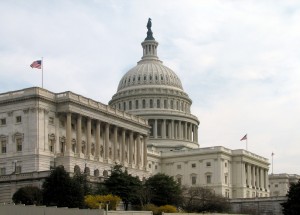 Mike Belliveau, executive director of Environmental Health Strategy Center in Maine, in a press release, issued the following statement in response to the Senate action: “Although improved, the Senate bill remains badly flawed. In a shameful give-away to chemical manufacturers and other multinational industries, the Senate bill would actually weaken current law.” The House bill lacks the same flaws that appear in the Senate bill. The House bill does not give a free pass to toxic toys or take away (preempt) the authority of the states to regulate these toxic materials.
Mike Belliveau, executive director of Environmental Health Strategy Center in Maine, in a press release, issued the following statement in response to the Senate action: “Although improved, the Senate bill remains badly flawed. In a shameful give-away to chemical manufacturers and other multinational industries, the Senate bill would actually weaken current law.” The House bill lacks the same flaws that appear in the Senate bill. The House bill does not give a free pass to toxic toys or take away (preempt) the authority of the states to regulate these toxic materials.
The serious problems with the Senate bill include the following:
- The legislation makes it more difficult for EPA to identify and intercept imported products containing a toxic chemical.
- States will be blocked (preempted) from taking action while EPA studies a chemical, potentially delaying urgent public health interventions.
- The “low priority” category requires EPA to greenlight some chemicals without a thorough safety review.
- There are numerous requirements placed on EPA at industry’s behest that divert scarce resources from the core purpose of identifying and restricting chemicals that cause harm.
Jay Feldman, executive director of Beyond Pesticides commented on the bill: “We know from our experience with pesticide regulation that when it comes to restricting uses  of toxic chemicals, it is absolutely critical to preserve the right of states to adopt more stringent standards than the federal government. Historically, it very often is the action of states that has lead the way in protecting health and environment, with federal regulation following. Because of this, it is an absolute bottom line to ensure that states have the authority to adopt standards more protective than the federal government without any strings attached, since reviews can go on for extended periods of time. In the pesticide arena, without this right, the nation may have taken years longer or never in the end have banned the use of DDT, DBCP, 2,4,5-T, EDB, and chlordane.”
In 2011, the first version of a TSCA overhaul  bill, titled the Safe Chemicals Act, was introduced by Senator Frank Lautenberg. That bill would have instituted a risk assessment methodology, similar to the one used on pesticides today, which, in theory, requires chemical companies to prove that their products are “safe” for human health and the environment before allowed into commerce. In reality, EPA’s risk assessment fails to look at chemical mixtures, synergistic effects, certain health endpoints (such as endocrine disruption), disproportionate effects to vulnerable population groups, and regular noncompliance with product label directions. In the end risks may be allowed that are unnecessary, given the availability of less or non-toxic alternatives. These deficiencies contribute to its severe limitations in defining real world poisoning, as captured by epidemiologic studies in the database. Beyond Pesticides has long criticized the risk assessment methodology used by EPA under pesticide law,  encouraging an alternatives assessment which creates a regulatory trigger to adopt alternatives and drive the market to go green.
Then, in 2013, Senator Lautenberg partnered with Senator David Vitter to introduce S.1009, the Chemical Safety Improvement Act (CSIA). In August 2013, nine state Attorneys General sent a letter to the Senate Environment and Public Works Committee expressing their “deep concerns about unduly broad preemption language proposed in S.1009.” The proposed bill would have amended TSCA, which in its current form requires no testing of chemicals, including intermediate chemicals and so-called inert and often highly toxic ingredients used in the production of pesticides (pesticide use is regulated under a separate law, the Federal Insecticide, Fungicide and Rodenticide Act).
Manufacturers are only required to provide the U.S. Environmental Protection Agency (EPA) with  90 days premarket notification before a new chemical is introduced for public consumption. Even after entering the market, the testing and regulation thresholds for these chemicals are grossly inadequate. The major downfalls of TSCA are that testing is not done unless health effects are reported and an investigation is opened. Even then, the chemicals will not be regulated unless the contaminated product is produced in significant amounts, enters the environment in a substantial quantity or if there is significant human exposure.
Similarly to previous versions of TSCA overhaul  bills, the current form that has just passed through the Senate takes away states’ rights to prohibit dangerous chemicals, also known as state preemption. According to the Environmental Health Strategy Center’s press release, the Senate bill “takes away states’ rights in a manner unprecedented in the history of federal environmental policymaking.  It blocks states like Maine and California from restricting dangerous chemicals after the U.S. Environmental Protection Agency simply begins to study a chemical’s danger.  That means that known dangerous chemicals will remain unattended at any level of government for years.  Even though the federal government hasn’t yet acted on a high priority chemical, states will be banned from taking action.”
The Senate bill would prevent states from regulating chemicals  months or even years  before a single protective federal regulation becomes effective, leaving an enormous gap in chemical safety protections and exposing human health and the environment to undue harm. State authorities, public health groups, and environmental advocates alike have cause for concern. Lobbying for  preemption laws is a tried and true practice of the chemical industry. Arguing under the guise of coherence and a unified national approach, chemical industry leaders would prefer weaker, uniform standards that fail to account for localized needs and sensitive populations.
Beyond Pesticides continues to fight for strong, public protections against chemicals in our homes and environment and any form of legislation that would diminish the right of communities and individuals alike to establish protective laws, regulations, and standards in the face of involuntary exposure.
Source: Environmental Health Strategy Center’s Press Release; Safer Chemicals, Healthy Families’ Press Release
All unattributed positions and opinions in this piece are those of Beyond Pesticides.
Posted in Announcements, National Politics, Pesticide Regulation by: Beyond Pesticides
No Comments
18
Dec
(Beyond Pesticides, December 18, 2015) One of the most likely causes for the population decline of smallmouth bass in the Susquehanna River are endocrine-disrupting compounds and herbicides, concludes a multi-agency, multi-year study of one of the most complex river systems in Pennsylvania. The Pennsylvania Department of Environmental Protection (DEP) and the Pennsylvania Fish and Boat Commission (PFBC), along with nearly 50 participants and six partner agencies, released findings on Monday that narrow the likely causes from an initial field of 14 candidates to two. PFBC also found that pathogens and parasites are probable contributing factors.
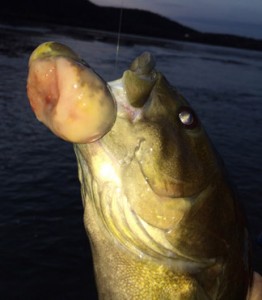 Following a smallmouth bass (SMB) population crash in 2005, and additional observed maladies, such as tumors and lesions on SMB, the team used ground-breaking monitoring strategies to collect more than 30,000 water quality records annually, along with review of existing research to isolate the possible causes keeping young-of-the-year (YOY) SMB from growing to adulthood. The study provides evidence to what Beyond Pesticides suspected back in May, when PFBC confirmed that a rare malignant tumor was found for the first time on a SMB caught by an angler back in the summer of 2014. Though the findings at the time did not point to a specific cause for the cancer found on the SMB, agricultural pesticides, particularly endocrine disrupting chemicals, that have been found in the watershed, likely play a part in the rampant disease issues in SMB in the Susquehanna River.
Following a smallmouth bass (SMB) population crash in 2005, and additional observed maladies, such as tumors and lesions on SMB, the team used ground-breaking monitoring strategies to collect more than 30,000 water quality records annually, along with review of existing research to isolate the possible causes keeping young-of-the-year (YOY) SMB from growing to adulthood. The study provides evidence to what Beyond Pesticides suspected back in May, when PFBC confirmed that a rare malignant tumor was found for the first time on a SMB caught by an angler back in the summer of 2014. Though the findings at the time did not point to a specific cause for the cancer found on the SMB, agricultural pesticides, particularly endocrine disrupting chemicals, that have been found in the watershed, likely play a part in the rampant disease issues in SMB in the Susquehanna River.
The next step is to focus on identifying the sources of the endocrine-disrupting compounds and herbicides, and what is causing the increased prevalence and lethality of the pathogens and parasites in smallmouth bass, including monitoring in the tributaries of the Susquehanna.
“We know where the herbicides are being applied most heavily and we know that exposure to them is depressing the immune systems of the bass,” said Fish and Boat Commission executive director John Arway to the Pittsburgh Post-Gazette.  “We’re inching closer, but the DEP is still not willing to say it’s the [farm] nutrients reaching the river.”
The Susquehanna River flows from upstate New York, south through Pennsylvania’s agricultural middle, and Maryland, and is the largest source of fresh water entering the Chesapeake Bay. It’s also a major source of agricultural runoff containing phosphorous, nitrogen and sediment pollutants, and natural animal hormones in manure, which could disrupt bass reproduction.
“This study does not identify a single smoking gun,” said John Quigley, DEP Secretary, in a press release. “But it does point the way toward likely causes, which we will continue to pursue. On top of that, through this study, DEP staff developed new approaches to monitoring this complex system, dramatically increasing our water quality monitoring capacity in the Susquehanna River, and providing tools that we can use to ensure fishable, drinkable water statewide.”
Details of the study, a webinar to present the findings of the study, and the full report can be found here.
Last summer, research by the U.S. Geological Survey (USGS) showed a strong correlation between the occurrence of intersex characteristics on fish, which have been found in the Chesapeake Bay region, and areas of high agricultural use in Pennsylvania. Three species of fish were examined in three separate watersheds in the state to assess whether characteristics caused by hormones and hormone-mimicking compounds, such as immature eggs in male fish, were present. In aquatic environments, the presence of these intersex characteristics is widely used as a biomarker for assessing exposure to estrogenic chemicals, as well as anti-androgenic chemicals which inhibit development of male characteristics. Male smallmouth bass from all sites sampled had immature eggs in their testes; however, SMB in the Susquehanna drainage had a significantly higher prevalence and severity of these effects than sites in the Ohio drainage. When compared with  the percentage of agricultural land use, which is higher in the Susquehanna, a link was established.
Fish and other aquatic organisms face numerous risks from pesticide exposures, even at low levels. In fact, USGS scientists identified pesticides as one of the contaminants in the Potomac River linked to  intersex fish  observed there.  Atrazine, one of the most commonly used herbicides in the world, has been shown to affect reproduction of fish at concentrations below U.S. Environmental Protection Agency’s (EPA) water-quality guidelines. Concentrations of atrazine commonly found in agricultural streams and rivers have been associated with  a reduction in reproduction and spawning, as well as tissue abnormalities.
In fish and humans, endocrine disrupting effects include direct effects on traditional endocrine glands, their hormones and receptors, such as estrogens, anti-androgens, and thyroid hormones, as well as signaling cascades that affect many of the body’s systems, including reproductive function and fetal development, the nervous system and behavior, the immune and metabolic systems, the liver, bones and many other organs, glands and tissues. Hundreds of scientific articles have been published across the globe demonstrating how a broad selection of chemicals can interfere with the normal development at all ranges of exposure. Scientists discovered effects for some widely used chemicals at concentrations thousands of times less than federal “safe” levels of exposure derived through traditional toxicological tests. Whatever the exposure level, neither fish nor human are protected from most endocrine-disrupting chemicals present in our waterways.
Beyond Pesticides continues to fight to  prevent water pollution and harmful agricultural practices. Visit our Threatened Waters page and learn how organic land management practices contribute to healthy waters in the article, “Organic Land Management and the Protection of Water Quality.”
Sources: Pennsylvania Department of Environmental Protection; Pittsburgh Post-Gazette
All unattributed positions and opinions in this piece are those of Beyond Pesticides
Posted in Announcements, Aquaculture, Atrazine, Chemicals, Disease/Health Effects, Endocrine Disruption, Pennsylvania, Pesticide Residues, State/Local, Water, Wildlife/Endangered Sp. by: Beyond Pesticides
No Comments
17
Dec
(Beyond Pesticides, December 17, 2015) On September 25, Applebee Aviation’s license to spray pesticides commercially was suspended for one year, after an employee complained of chemical exposure and violated worker protection rights. After Applebee Aviation’s one-year suspension was issued, it  continued to operate and illegally sprayed at least 16 sites, according to reports.  Two of those sites were public parks, 71 acres in total, overseen by the Oregon Department of Forestry (ODF).
 A series of back-and-forth communications between the Oregon Department of Agriculture and Applebee Aviation has resulted in a restraining order, $180,000 in fines, a five-year license revocation, and over 800 acres of state
A series of back-and-forth communications between the Oregon Department of Agriculture and Applebee Aviation has resulted in a restraining order, $180,000 in fines, a five-year license revocation, and over 800 acres of state
and private land illegally sprayed. According to recent investigations, ODF knew about the license revocation before Applebee Aviation illegally sprayed state forests.
In April 2015, Applebee Aviation employee Darryl Ivy, a truck driver, spent 17 days on a spray crew in Oregon timber country. During that time, he and his crew were routinely exposed to aerial sprays. Mr. Ivy took shelter in his truck while a “milky chemical mixture” rained overhead and stained his vehicle. In the emergency room, Mr. Ivy’s urine showed elevated levels of the herbicide atrazine, a known endocrine disruptor. He suffered from sores and rashes and was spitting up blood. Before going to the hospital, however, Mr. Ivy managed to capture videos and photos of the spraying. Those videos were submitted to the Oregon Occupational Safety and Health (OSHA) and the Department of Agriculture (ODA), which on September 25, fined Applebee $8,850 and $1,100 respectively, citing a total of 22 “serious violations” related to herbicide exposure. According to the OSHA report, “The company did not provide emergency eye wash or decontamination, proper information and training, or protective equipment.”
In the 16 days that followed the suspension, it has been reported that Applebee illegally sprayed 16 different sections of forest, including a state park spray overseen by Charlie Moyer, a department district forester. According to the report, the sprays were authorized by Applebee Aviation owner, Michael Applebee, who directed his employees to disregard the suspension. State attorneys representing the Department of Agriculture responded by obtaining a restraining order against Applebee to prevent further violations.
According to a local radio station, “On October 7, just after 11 a.m., Lisa Arkin of the anti-pesticide group Beyond Toxics sent an email to agriculture and forestry officials asking why Applebee Aviation was still listed on upcoming forestry jobs. Ms. Arkin copied several state legislators and the governor’s office on the message. ”˜It doesn’t seem like the right hand knows what the left hand is doing,’ Ms. Arkin later said in a phone interview.”
On November 5, ODA revoked Applebee Aviation’s commercial pesticide operator license and fined the company and its owner a total of $180,000. “Issuing $180,000 in civil penalties and five-year license revocations against Applebee Aviation underscores how serious the Oregon Department of Agriculture considers the violations that have taken place,” says ODA Director Katy Coba.
“We take all violations of the state’s pesticide law seriously. The fact that this operator knowingly and willfully continued to conduct pesticide applications 16 times after receiving a suspended license shows contempt for state regulations and our department. We cannot and will not tolerate such disregard for the law by which all pesticide operators are expected to live by.”
Michael Applebee told local media that he was being used as a scapegoat. “People from Eugene south do not like pesticides,” Mr. Applebee said. “If there’s a problem with pesticides and people don’t want it, we should figure out what to do about it — not beat down on Mike Applebee.”
Now, media, environmentalists, and lawmakers are looking to recent investigations, which found that ODF officials knew Applebee had lost its  license before state and private land were sprayed. According to the ongoing investigation, notification of the suspension seems to have been delayed or forgotten. Reports are unclear as to whether state agencies notified state officials by phone or emails and whether the timing of that communication resulted in illegal sprays.
Applebee Aviation is the center of multiple investigations. Since 2010, Applebee Aviation has had 15 complaints filed against it, more than any other chemical applicator in the state. In August, an Applebee Aviation chemical delivery truck crashed and spilled 500 gallons of water containing  glyphosate  residue as well as diesel fuel just off Highway 199 in Northern California, along the Smith River. Mr. Ivy had previously reported to authorities that Applebee did not properly maintain the brakes and pesticide tank seals on their trucks. In November, a fifth Applebee Aviation helicopter in five years crashed during a Christmas tree harvesting operation.
All unattributed positions and opinions in this piece are those of Beyond Pesticides.
Source: Oregon Public Broadcasting, EarthFix
Posted in Agriculture, Announcements, National Politics, Oregon, Pesticide Drift, Pesticide Regulation, Pesticide Residues, State/Local by: Beyond Pesticides
1 Comment
16
Dec
(Beyond Pesticides, December 16, 2015)  The U.S. Department of Agriculture (USDA) has announced  the availability of  funding to support  initiatives aimed at  improving organic agriculture. The funding, in the form of grants  totaling  $17.6 million,  is to support research and outreach activities to help organic growers, producers and processors find innovative ways to  advance  organic agriculture. Organic agriculture has grown tremendously over the last decade to a $35 billion dollar industry  to become  the fastest growing sector of agriculture.
Agriculture Secretary  Tom Vilsack made  the announcement  last week that  the grants,  made available  through the”¯Organic Agriculture Research and Extension Initiative”¯(OREI) —a program that is administered by USDA’s  National Institutes of Food and Agriculture (NIFA) and authorized by the 2014 Farm Bill, will aid farmers and ranchers with whole farm planning by delivering  “practical  research-based information and will improve the ability of growers to develop  organic system plans”  as required for certification under the Organic Foods Production Act (OFPA).  Applications are due March 10, 2016. Please see the”¯request for applications”¯for specific program requirements.
National Institutes of Food and Agriculture (NIFA) and authorized by the 2014 Farm Bill, will aid farmers and ranchers with whole farm planning by delivering  “practical  research-based information and will improve the ability of growers to develop  organic system plans”  as required for certification under the Organic Foods Production Act (OFPA).  Applications are due March 10, 2016. Please see the”¯request for applications”¯for specific program requirements.
“Over the past six years, USDA has strengthened programs that support organic producers as they grow, thrive and respond to increasing consumer demand for organic products,” said  Secretary Vilsack. “The projects funded through the Organic Agriculture Research and Extension Initiative will help identify innovative solutions to critical challenges facing organic agriculture, ultimately strengthening local markets, improving rural economies and expanding access to healthy food for Americans.”
According to the  press release issued by NIFA, the purpose of the OREI program is  “to fund high-priority research, education, and extension projects that enhance the ability of producers and processors who have already adopted organic standards to grow and market high quality organic products. Priority concerns include biological, physical, and social sciences, including economics.” Previous grants, amounting to $19 million in 2013 and $14 million in 2012, included  projects  investigating  the ecological role of wild birds on vegetable farmers, providing owners with practical, science-based recommendations for wild bird management. Other projects focused on looking at the cost and benefits of cover crop mixtures, and undergraduate organic education for next generation growers and researchers.
Reports cite  that consumption of  organic products has continued to increase at a monumental pace, and according to”¯a 2014 Gallup poll, nearly half of all U.S. adults “actively” seek to add organic food to their diets.  Recent studies  have found health benefits associated with eating an organic diet, including  higher levels of nutrients and antioxidants in organically grown produce, and  better quality milk.”¯  In 2012, the American Academy of Pediatrics (AAP)  weighed in”¯on the organic food debate recognizing that lower pesticide residues in organic foods may be significant for children. The Academy also noted that choosing organic is based on”¯larger  environmental issues, as well as human health impacts”¯like pollution and global climate change.
However, the integrity of organic has been under threat. A recent legal suit filed earlier this year by Beyond Pesticides, Center for Food Safety and Center for Environmental Health challenged  the National Organic Program’s (NOP)  failure to follow proper legal procedures”¯in making a substantial rule change that  allows  contaminants in compost. Similarly,  another lawsuit”¯brought by 15 farm, consumer and certifier organizations raised  a similar  procedural challenge”¯to a”¯rule change to the organic sunset process, which regulates synthetic chemical exceptions in organic production.  In  that  case,  USDA  took unilateral action to adopt a major policy change without public process, an action plaintiffs maintain violates a  foundational principle and practice of OFPA public participation in organic policy making and the standards of the Administrative Procedure Act.”¯See  Beyond  Pesticides’”¯Keeping Organic Strong”¯webpage to learn more about these and other issues.
Beyond Pesticides advocates in its organic food  program and through its”¯Eating with a Conscience  (EWAC)”¯website choosing organic because of the environmental and health benefits to consumers, workers, and rural families. For more information on the benefits of organic agriculture, see Beyond Pesticides’”¯Organic Food program page.
All unattributed positions and opinions in this piece are those of Beyond Pesticides.
Source: NIFA Newsroom Â
Posted in Agriculture, Alternatives/Organics, Announcements, Environmental Justice, Litigation, National Politics by: Beyond Pesticides
No Comments
15
Dec
(Beyond Pesticides, December 15, 2015) Last week Montreal, the largest city in Canada’s Quebec province, announced plans for an all-out ban on the use of bee-toxic neonicotinoid pesticides. The new regulations represent the strongest move against this neurotoxic class of insecticides by any government entity to date. Environmental and health advocates are praising the ban as a sign that more and more localities in North America are finding these chemicals unnecessary to manage pest problems, and not worth the risk to pollinators and other wildlife.
Montreal’s regulations provide for a complete ban, “without exception,” on the use of neonicotinoids outside of buildings on City land. Prior to the new rules, private citizens and businesses could obtain a temporary permit for  the use of neonicotinoids in the  case  of an infestation, however, the permit will no longer be available and citizens will be encouraged to employ alternative practices or products. The ban will also apply to golf courses and properties in the City used for agricultural and horticultural purposes.
the use of neonicotinoids in the  case  of an infestation, however, the permit will no longer be available and citizens will be encouraged to employ alternative practices or products. The ban will also apply to golf courses and properties in the City used for agricultural and horticultural purposes.
“By adopting a regulation that prohibits the use of such pesticides in Montreal, our Administration places the health of its citizens, the quality of life of its neighborhoods and the preservation of biodiversity, natural environments and green spaces in the center of its concerns,” said Réal Ménard, head of sustainable development, environment, large parks and green spaces for Montreal. “This tighter control of pesticides will, among other to better protect bees and other pollinators.”
Montreal’s move follows a major overhaul of pesticide laws announced in late November 2015 by Quebec province. Quebec acted to restrict the use of “high risk” pesticides such as neonicotinoids, atrazine, and organophosphates in both agriculture and urban and residential environments.
As the science linking neonicotinoids to the decline of honey bees and other wild pollinators continues to strengthen, more and more governments are taking action to reduce or eliminate their use in pest management. In the U.S., local governments in Minneapolis, MN, Lafayette and Boulder, CO, Portland, OR, Montgomery County, MD, and numerous other locations have restricted or eliminated the use of neonicotinoids on public and/or private property. Like Montreal, these localities are not simply aiming to replace neonicotinoids with another toxic pesticide, but alter their pest management approach by putting an emphasis on prevention, monitoring, and cultural, mechanical and biological controls if pest problems do get out of hand.
Montreal’s new regulations reveal that neonicotinoids are simply not necessary in settings long considered a third rail for pesticide regulation in the U.S.: golf courses and agriculture. In 2014, EPA  released a memorandum  concluding that soybean  seeds treated with neonicotinoid insecticides provide little or no overall benefits in controlling insects or improving yield or quality in chemical-intensive soybean production.  The memo states, “In studies that included a comparison to foliar insecticides, there were no instances where neonicotinoid seed treatments out-performed any foliar insecticide in yield protection from any pest.” Furthermore, preliminary reports out of the UK find that the country is poised to  harvest higher than expected yields of canola  in its first neonicotinoid-free growing season since a  European moratorium on neonicotinoids  went into place in 2013. In golf, grubs are often the target of neonicotinoids, but a growing number of alternative products and practices continue to be developed.
Take Action:
Grassroots change happens when committed individuals come together for the common good. Help push for restrictions on neonicotinoids and other toxic pesticides in your community. To become active, contact Beyond Pesticides for resources and factsheets available to help you organize and reach your local elected officials. Give us a call (202-543-5450) or email ([email protected]) for one-on-one consultation about the strategies you can take to have a positive impact on local pollinators.
All unattributed positions and opinions in this piece are those of Beyond Pesticides.
Source: City of Montreal Press Release
Posted in Agriculture, Announcements, Chemicals, International, neonicotinoids, Pollinators, Take Action by: Beyond Pesticides
1 Comment
14
Dec
(Beyond Pesticides, December 14, 2015) Chemical giants DuPont and Dow Chemical Companies announced that their boards of directors unanimously approved a merger of their companies through an all-stock deal, valuing the combined market capitalization at $130 billion. According to the Washington Post, “The combined company, analysts said, would be  the world’s largest seed and pesticide  conglomerate,  controlling  17 percent of global pesticide sales  and about 40 percent of  America’s corn-seed and soybean markets.”
 The  press release, states “The combined company will be named DowDuPont. The parties intend to subsequently pursue a separation of DowDuPont into three independent, publicly traded companies through tax-free spin-offs. This would occur as soon as feasible, which is expected to be 18-24 months following the closing of the merger, subject to regulatory and board approval.” The merger could revive attempts at consolidation between other big companies in the agrochemical industry.
The  press release, states “The combined company will be named DowDuPont. The parties intend to subsequently pursue a separation of DowDuPont into three independent, publicly traded companies through tax-free spin-offs. This would occur as soon as feasible, which is expected to be 18-24 months following the closing of the merger, subject to regulatory and board approval.” The merger could revive attempts at consolidation between other big companies in the agrochemical industry.
After the DowDuPont merger closes, the three businesses that the boards intend to separate are:
Agriculture Company: “Leading global pure-play agriculture company that unites DuPont’s and Dow’s seed and crop protection businesses.” Revenue: $19 billion.
Material Science Company: “A pure-play industrial leader, consisting of DuPont’s Performance Materials segment, as well as Dow’s Performance Plastics, Performance Materials and Chemicals, Infrastructure Solutions, and Consumer Solutions … operating segments.” Revenue: $51 billion.
Specialty Products Company: “The businesses will include DuPont’s Nutrition & Health, Industrial Biosciences, Safety & Protection and Electronics & Communications, as well as the Dow Electronic Materials business.” Revenue: $13 billion.
Reuters, in its  analysis of the merger, stated that, “The merger puts further pressure on rivals such as Germany’s BASF SE and Bayer AG to consolidate as falling crop prices curb sales. It could also prompt a renewed flurry of takeover bids for European rivals, with Syngenta AG the most likely target. Analysts have said a Dow-DuPont tie-up might push Monsanto Company to take another shot at Syngenta after the U.S. company abandoned a $45 billion offer for the Swiss company in August.” Many of these big agricultural companies have been struggling to cope with falling demand for farm chemicals due to falling crop prices and a strong dollar, and may believe that a merger will provide longer-term security.
However, for the billion-dollar agrochemical industry, a merger is likely to only provide short-term stability, increase the wealth of top executives, and raise the cost of food, as the new corporation will create a near monopoly that  will allow it  to increase prices. In the long-term, the market will reveal that relying on the promotion of chemical-intensive agricultural practices is not a sustainable business practice. Chemical-intensive (or conventional)  agriculture depends on chemical fertilizers and toxic pesticides that have been shown to reduce soil organic matter and decrease the diversity of soil biota. These chemical inputs contaminate waterways leading to eutrophication and “dead zones,” where nothing is able to live or grow. Eventually, as chemical intensive agriculture depletes organic matter in the soil and there is nothing left with which to grow food or sustain life, chemical inputs will become obsolete. Sustainability advocates say that the  only way that the agricultural industry can create a sustainable business model is to produce products that are compatible with  organic agriculture.
While some argue that organic is too expensive, the simple fact is that chemical companies are able to externalize the social cost of their products in the form of eutrophication, soil erosion, harm to wildlife, healthcare costs to consumers, and numerous other adverse effects. Some researchers calculate the adverse impacts to health and the environment to be as much as $16.9 billion a year. (Tegtmeier and Duffy 2004) If consumers paid the true cost of conventional food production, prices for conventionally grown goods would certainly be more expensive than organic products, which are certified through a process that protects human health and the environment.
Good organic practices work to build the soil and maintain an ecological balance that makes chemical fertilizers and synthetic pesticides obsolete. Claims that organic agriculture cannot feed the world because of lower yields are contested by scientific studies showing that organic yields are comparable to conventional yields and require significantly lower inputs. Organic agriculture advocates say that it is not only necessary in order to eliminate the use of toxic chemicals, but to ensure the long-term sustainability of food production.
For further information, check out our webpages on Organic Agriculture.
Source: Reuters, NPR, DowDuPont Press Release
All unattributed positions and opinions in this piece are those of Beyond Pesticides.
Posted in Uncategorized by: Beyond Pesticides
No Comments
11
Dec
(Beyond Pesticides, December 11, 2015) Milk contaminated with the long-banned and toxic organochlorine pesticide heptachlor in Hawaii has been found  in the brains of men that were more likely to develop Parkinson’s disease, according to a new study. This study adds to a large body of evidence linking pesticide exposure to Parkinson’s disease.
 Researchers of the study, titled “Midlife milk consumption and substantia nigra neuron density at death” and published in the journal Neurology, collected milk intake data from 1965 to 1968 for 449 men aged 45-68 years withpostmortem examinations from 1992 to 2004. Neuron density was measured in an area of the brain called substantia nigra (SN). As Parkinson’s develops, cells are destroyed in certain parts of the brain stem, particularly in the SN, a crescent-shaped cell mass. Measurements of brain residues of heptachlor epoxide, a heptachlor metabolite that is persistent and more toxic than its parent chemical, were also taken.
Researchers of the study, titled “Midlife milk consumption and substantia nigra neuron density at death” and published in the journal Neurology, collected milk intake data from 1965 to 1968 for 449 men aged 45-68 years withpostmortem examinations from 1992 to 2004. Neuron density was measured in an area of the brain called substantia nigra (SN). As Parkinson’s develops, cells are destroyed in certain parts of the brain stem, particularly in the SN, a crescent-shaped cell mass. Measurements of brain residues of heptachlor epoxide, a heptachlor metabolite that is persistent and more toxic than its parent chemical, were also taken.
“Among those who drank the most milk, residues of heptachlor epoxide were found in 9 of 10 brains as compared to 63.4%…for those who consumed no milk,” the researchers wrote. Neuron density was lowest in subjects who consumed the highest amounts of milk.
The researchers looked at milk because it can bioconcentrate, or accumulate, certain organic pollutants such as organochlorine pesticides. Hawaii is an area that is of particular importance due to excessively high levels of heptachlor epoxide what were reported to contaminate the milk supply during the time that study participants were being followed. Heptachlor was widely used on  pineapple plantations and the “green chop,” or tops of the pineapple, were fed to cows. It was widely known that milk was contaminated with elevated levels of helptachlor in the 1980’s. EPA allowed the use of heptachlor on pineapples to continue long after other agricultural uses had been suspended.
Heptachlor was used as an insecticide between 1953 and 1974 as a soil and seed treatment; however, nearly all registered uses of heptachlor have been canceled. Uses continued in Hawaii under an exemption until 1994. EPA has classified heptachlor as a Group B2 probable human carcinogen.
Parkinson’s disease is a degenerative disorder of the central nervous system that affects the motor system, resulting in symptoms of tremor, stiffness, or slowing of movement. Organochlorine pesticides may have a role in the causation of Parkinson’s.  In 2013, a study revealed that individuals with a genetic mutation were at  increased risk of Parkinson’s disease  if they were also exposed to low doses of pesticides. Another study in the journal  Cell  also provides firm evidence  linking pesticides to Parkinson’s disease, as the researchers used pesticides to find the mechanisms by which the disease manifests itself. Beyond Pesticides has worked to increase public awareness of the link between pesticide use and Parkinson’s disease through the Pesticide Induced Diseases Database, which currently features  over 100 peer-reviewed studies that have researched the pesticides-Parkinson’s connection.
As the connection between Parkinson’s and pesticide use becomes increasingly clear, pressure will continue to build for practices and methods that exclude pests without the use of hazardous chemicals. Whether in airplanes, farms, gardens, lawns, waterways, inside one’s own home, or the numerous other places where pesticides are often used, there are non-toxic and least-toxic alternatives that do not necessitate the use of hazardous chemicals. For more information on the link between pesticides and Parkinson’s, see Beyond Pesticides’  Pesticide Induced Diseases Database, or read our 2008  Pesticides and You  article “Pesticides Trigger Parkinson’s Disease.”
Sources: Neurology; NBC News
All unattributed positions and opinions in this piece are those of Beyond Pesticides.
Posted in Announcements, Chemicals, Disease/Health Effects, organophosphate, Parkinson's by: Beyond Pesticides
No Comments
10
Dec
(Beyond Pesticides, December 10, 2015) Researchers at Pennsylvania State University (Penn State) and the Pennsylvania Association for Sustainable Agriculture published a study, which found that aerial drift of the herbicide dicamba adversely affects non-target plants and pollinator species. Dicamba is a chlorinated benzoic acid herbicide associated with neurotoxicity and reproductive effects. The study used alfalfa crops to track the flowering and floral visitation by insects, specifically pollinators, after applications of sublethal doses of dicamba. The researchers concluded, “Our results suggest that widespread non-target damage from these herbicides may adversely affect pollinator communities.”
 Because dicamba is “frequently responsible for sublethal, off-target damage” to plants and insects, Penn State researchers assessed the most common route of exposure: particle and vapor drift. In its  study, Effects of the Herbicide Dicamba on Nontarget Plants and Pollinator Visitation, the research team examined the crop species alfalfa (Medicago sativa), which requires insect pollination to produce seeds, and the native plant species common  boneset (Eupatorium perfoliatum), which is highly attractive to a wide range of pollinator species. The researchers applied a range of sublethal doses of dicamba to the plants, then tracked flowering and floral visitation by insect species. They identified the types of insects visiting the flowers and analyzed pollen quality to determine if herbicide exposure altered pollen quality. “We found that both plant species are susceptible to very low rates of dicamba — just 0.1 to 1 percent of the expected field application rate can negatively influence flowering,” said John Tooker, Ph.D., entomologist and extension specialist at Penn State. “This will lead to higher levels of non-target damage to susceptible crop plants and native, wild vegetation”¦For non-crop plant species, this drift-induced damage could significantly decrease the pollinator and natural enemy communities that these plants can support,” he explained.
Because dicamba is “frequently responsible for sublethal, off-target damage” to plants and insects, Penn State researchers assessed the most common route of exposure: particle and vapor drift. In its  study, Effects of the Herbicide Dicamba on Nontarget Plants and Pollinator Visitation, the research team examined the crop species alfalfa (Medicago sativa), which requires insect pollination to produce seeds, and the native plant species common  boneset (Eupatorium perfoliatum), which is highly attractive to a wide range of pollinator species. The researchers applied a range of sublethal doses of dicamba to the plants, then tracked flowering and floral visitation by insect species. They identified the types of insects visiting the flowers and analyzed pollen quality to determine if herbicide exposure altered pollen quality. “We found that both plant species are susceptible to very low rates of dicamba — just 0.1 to 1 percent of the expected field application rate can negatively influence flowering,” said John Tooker, Ph.D., entomologist and extension specialist at Penn State. “This will lead to higher levels of non-target damage to susceptible crop plants and native, wild vegetation”¦For non-crop plant species, this drift-induced damage could significantly decrease the pollinator and natural enemy communities that these plants can support,” he explained.
“Because of the challenge of glyphosate-resistant weeds, new types of transgenic crops that are resistant to synthetic-auxin herbicides including dicamba and 2,4-D will be widely planted in coming growing seasons, raising concerns about damage from these drift-prone herbicides,” said Dr. Tooker. Herbicide currently accounts for 50% of pesticide use in the United States. “The expected high rate of adoption of the new transgenic crops will increase dicamba and 2,4-D use by four to eight times.
Dicamba and 2,4-D are synthetic-auxin herbicides, meaning they mimic plant growth hormones, disrupting natural plant processes. According to  David Mortensen, Ph.D., professor of  weed and applied plant ecology at Penn State, “Synthetic-auxin herbicides are usually used early in the growing season, but with the new transgenic crop varieties coming on the market, these herbicides will be used later when temperatures are warmer and more plant species are leafed out.” This could also increase the possibility that bees encounter these herbicides or the plants affected by them.
Studies like this one are imperative to position the safeguards needed to protect pollinators and the crops dependent on their pollination. According to a 2012 study, pollination services for all crops requiring direct pollination annually exceed $15 billion, and wild bee communities provide nearly $3.5 billion worth of these pollination services. While neonicotinoids (neonics) have been the focus of the pollinator decline discussion, other pesticides have been found to adversely affect pollinators. A recent study conducted by Germans and Argentinian researchers found that honeybees exposed to low doses of glyphosate have a hard time returning home.
Glyphosate used in herbicide-tolerant crops,  has resulted in the creation of GE crops resistant to chemicals like dicamba and 2,4-D. Because of glyphosate overreliance, there are at least 29 weed species worldwide that are resistant to glyphosate. Previously, “Roundup Ready” crops were thought to make herbicide application easier; instead, it inadvertently created a resistance that led to new GE crop systems, like Enlist Duo (glyphosate and 2,4-D). Because weeds have mutated to tolerate almost every form of herbicide weed control system sent their way, farmers are experiencing problems with super weeds and, in turn, invest in chemical-intensive systems that harm human health and the environment.
As the crisis in weed resistance escalates, threatening crop productivity and profitability, advocates point to organic agriculture as a solution that protects public health, the environment, pollinators, and farmers’ livelihood. Ecological pest management strategies, organic practices, and solutions that are not chemical-intensive are the most appropriate and long-term solution  to managing unwanted plants, or weeds. Additionally, organic agriculture is an ecologically-based management system that prioritizes cultural, biological, mechanical production practices, and natural inputs. By strengthening on-farm resources, such as soil fertility, pasture and biodiversity, organic farmers can minimize and even avoid the production challenges that most genetically engineered organisms have been falsely-marketed as solving. To learn more about organic agriculture, see  Beyond Pesticides Organic Program Page.
All unattributed positions and opinions in this piece are those of Beyond Pesticides.
Source: Pennsylvania State University
Posted in 2,4-D, Agriculture, Alternatives/Organics, Announcements, Chemicals, Dicamba, Glyphosate by: Beyond Pesticides
No Comments
09
Dec
(Beyond Pesticides December 9, 2015) Last week, the Oregon Health Authority (OHA) signaled its willingness to address a gap in the regulation  of pesticides in  marijuana production caused by a lag in the start date of the state’s revised testing program. After new regulations were adopted  last month to increase the amount of pesticide residue testing on cannabis required by the state, concerns were raised about the delayed  June 2016 start date. The  committee that advises OHA on medical marijuana pressured the agency to expedite the rules.
While a final decision is pending, the   stop-gap testing rules would target the most commonly used pesticides in marijuana production and go into effect as early as January. Advocates are urging states to ban registered pesticides, since they are not labeled for use on marijuana and not evaluated for exposure associated with inhalation, ingestion, and dermal absorption, as well as potential environmental contamination. 70,000-plus medical marijuana users, as well as recreational users, within the state will be affected by the regulations.
In November, the state of Oregon updated its rules governing pesticide use to require the mandatory testing of nearly  60 pesticide compounds  that are of particular concern.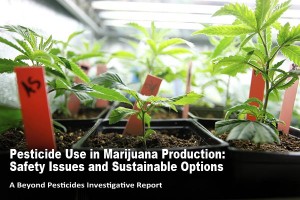 Under the new rules, all growers will be required to undergo this testing, and failure will result in the untested batch being destroyed. This is a change from prior rules which allowed laboratories to determine on their own what pesticides to include in a screening. This change was deemed necessary in light of  The Oregonian  findings  that some labs had stopped testing for a common pesticide that is included in the new rules because failed samples hurt its business.
Under the new rules, all growers will be required to undergo this testing, and failure will result in the untested batch being destroyed. This is a change from prior rules which allowed laboratories to determine on their own what pesticides to include in a screening. This change was deemed necessary in light of  The Oregonian  findings  that some labs had stopped testing for a common pesticide that is included in the new rules because failed samples hurt its business.
Mowgli Holmes, Ph.D., a scientist and founder of Phylos Bioscience, a Portland-based company that performs genetic research on cannabis, serves as a member of the advisory panel to OHA and is one of the biggest advocates for addressing the in-between time created by Oregon’s new regulations. Dr.Holmes has been evaluating the potential dangers associated with the unregulated use of pesticides on marijuana, and in June produced a white paper on the subject entitled “Pesticide Use on Cannabis,” which cites Beyond Pesticides’ report on “Pesticide Use in Marijuana Production.” Last week, Dr. Holmes pushed the health authority to ditch its current requirement that marijuana be tested for four broad classes of chemicals and instead require testing for 10 or 12 of the most commonly used pesticides. He believes  that focusing on these dozen or so “bad actors” would push growers of medical marijuana to “wean themselves” quickly from their longstanding practices of pesticide use, as any sample that tested positive for one of the compounds on the list would be “denied clearance for commercial sale,” according to Dr. Holmes’ proposal.
Oregon’s existing rules for pesticide analysis are broad and fail to target the chemicals that chemical-intensive cannabis producers commonly use to control mites, mold and mildew. Currently a cottage industry of marijuana labs, operating without government oversight, can pick and choose which pesticides to include in their routine screenings, often omitting tests for the most commonly used pesticides. This ensures that growers submitting their products for testing can “pass” inspections and place their crop on the market while still being able to claim that the product has been tested for pesticide residue. To address  this issue, Dr. Holmes suggests that every transfer of marijuana from grower to dispensary should be accompanied by a certificate produced by the testing lab. He proposes that the  certificate includes the names of the pesticides tested, and whether the pesticide was detected and at what level. All of the information would then be available to the state agency that is accrediting marijuana labs.
However, because Oregon Health Authority presently lacks direct enforcement authority over laboratories to ensure reliable testing results, Dr. Holmes concedes that enforcement would likely remain a problem in the proposed transitional testing system, as labs within the state will not fully be accredited until next summer under the new rules. The variation in laboratories standards raises additional problems.
For months, government officials in states that have legalized marijuana have not resolved  with the Environmental Protection Agency (EPA) and other federal agencies issues regarding the  regulation of pesticides in marijuana production. Quarantines on pesticide-laced cannabis  in Denver, Colorado,  a warning letter and testimony delivered by Beyond Pesticides, and  a recent lawsuit against a major Colorado grower  may have encouraged  Governor John Hickenlooper to issue an executive order directing state agencies to address public safety concerns related to pesticide-contaminated cannabis.  Additionally agencies within  Colorado and Washington State  have created and published a list of allowed pesticides on cannabis that have come under scrutiny for their inclusion of pesticides whose use would violate existing federal law, according to safety advocates.
The Organic Approach
While recent moves in Colorado, Oregon, and  previously in California  represent steps in the right direction, they also contain significant pitfalls and loopholes that allow contaminated cannabis to market where it threatens public health. Beyond Pesticides continues to encourage states to take a stronger approach to regulating this budding industry, so that it blazes an agricultural path that protects its most sensitive at-risk users. Three elements must be passed and enforced in order to do so. They are:
1. A prohibition on the use of federally registered pesticides on cannabis;
2. Allowance of pesticides exempt from federal registration, but not those that are only exempt from tolerances and;
3. Requirements for an organic system plan that focuses on sustainable practices and only 25b products as a last resort.
Beyond Pesticides maintains that implementing these three requirements will ensure the sustainable growth of a new agricultural industry, and lead to the protection of public health. For more information and background this important issue, see Beyond Pesticides’ report  Pesticide Use in Marijuana Production: Safety Issues and Sustainable Options.
All unattributed positions and opinions in this piece are those of Beyond Pesticides.
Source: The Oregonian
Posted in Announcements, Cannabis, Oregon, State/Local by: Beyond Pesticides
No Comments
08
Dec
(Beyond Pesticides, December 8, 2015) Exposure to common agricultural pesticides in early life leads to a measurable decrease in children’s lung functioning, according to researchers from the University of California, Berkeley. Organophosphate pesticides, a relatively older generation of crop chemicals still widely used on farms in California, have been associated with a broad range of diseases in both children and adults. This latest study adds to calls from health and environmental advocates to eliminate these toxic pesticides in agriculture, and move towards safer, sustainable, and organic management practices.
 The higher the rate of organophosphate exposure, the smaller a child’s lung capacity would be, scientists found. The UC Berkeley study traces exposure by looking at pesticide metabolites in urine five  times over the course of childhood (6 months to 5 years). Participants were part of the Center for the Health Assessment of Mothers and Children of Salinas (CHAMACOS), a longitudinal birth cohort study investigating the effects of pesticides and other environmental chemicals on the growth, health, and development of children in California’s Salinas Valley.
The higher the rate of organophosphate exposure, the smaller a child’s lung capacity would be, scientists found. The UC Berkeley study traces exposure by looking at pesticide metabolites in urine five  times over the course of childhood (6 months to 5 years). Participants were part of the Center for the Health Assessment of Mothers and Children of Salinas (CHAMACOS), a longitudinal birth cohort study investigating the effects of pesticides and other environmental chemicals on the growth, health, and development of children in California’s Salinas Valley.
For every 10-fold increase in pesticide metabolites measured in a child’s urine, an average of approximately 8% air function within the lungs was lost. “Researchers have described breathing problems in agricultural workers who are exposed to these pesticides, but these new findings are about children who live in an agricultural area where the organophosphates are being used,” said study senior author Brenda Eskenazi, PhD, a professor of epidemiology and of maternal and child health. “This is the first evidence suggesting that children exposed to organophosphates have poorer lung function.”
Scientists determined these results after adjusting for smoking during pregnancy, season of birth, exposure to particulate matter, breast feeding duration, mold and pets at home, distance of a home to a highway, food insecurity, mother’s education, season at which the test was administered, and the child’s height and gender, according to the study.
The authors indicate that the effect of pesticide exposure is equivalent to that seen when children are exposed to secondhand smoke.
“This study adds exposure to organophosphate pesticides to the growing list of environmental exposures — including air pollution, indoor cook stove smoke and environmental tobacco smoke — that could be harmful to the developing lungs of children,” said lead author Rachel Raanan, PhD. “Given they are still used worldwide, we believe our findings deserve further attention.”
Of paramount concern are the health implications for children with similar levels of exposure across the country. “If the reduced lung function persists into adulthood, it could leave our participants at greater risk of developing respiratory problems like COPD (chronic obstructive pulmonary disease),” said Dr. Raanan. A separate CHAMACOS study published earlier this year echoed the current findings, showing an association with pesticide exposure and possible asthma in childhood.
Organophosphates are pesticides derived from World War II nerve agents. In addition to being potent neurotoxicants, organophosphates are extremely harmful to the nervous system, as they are cholinesterase inhibitors and bind irreversibly to the active site of an enzyme essential for normal nerve impulse transmission. Although organophosphate use is on the decline in the U.S., the U.S. Environmental Protection Agency (EPA) has allowed the continued registration of many of these products. As a result of a lawsuit by environmental groups, the agency recently proposed a rule that would to remove one of the most potent organophosphates, chlorpyrifos, from use in agricultural production. However, EPA is not expected to finalize the rule until December 2016. Health and environmental advocates must remain vigilant of Dow, the pesticides’ manufacturer, and its ability to lobby Congress to protect its profits of children’s health.
Studies have documented that exposure to even low levels of organophosphates during pregnancy can impair learning, change brain function, and alter thyroid levels of offspring into adulthood. The evidence of hazards to children as a result of organophosphate exposure is robust and highly concerning, even for those that do not live in or around agricultural fields, as these chemicals are frequently detected on food.
The most surefire way consumers can avoid exposure to toxic organophosphates and protect children’s health is by supporting organic agriculture. Buying organic not only means that your food is safer, it means that the farmworkers who grow the food we eat and their children are not subject to toxic insult. Find out more about why organic is the right path forward for the future of farming by going to Beyond Pesticides’ organic agriculture webpage.
Source: Berkeley News, Thorax
All unattributed positions and opinions in this piece are those of Beyond Pesticides.
Posted in Agriculture, Alternatives/Organics, Announcements, California, Disease/Health Effects, organophosphate, Pesticide Drift, Pesticide Residues, Respiratory Problems, State/Local by: Beyond Pesticides
No Comments
07
Dec
(Beyond Pesticides, December 07, 2015) Monsanto will be put on trial for crimes against nature, humanity, and ecocide in The Hague, Netherlands, home to the United Nation’s International Court of Justice. The Organic Consumers Association (OCA), IFOAM International Organics, Navdanya, Regeneration International (RI), and Millions Against Monsanto, joined by dozens of global food, farming and environmental justice groups announced late last week that they will put the U.S.-based transnational corporation on trial next year on World Food Day, October 16, 2016.
 The announcement was made at a press conference held in conjunction with the COP21 United Nations Conference on Climate Change, November 30 — December 11, in Paris.
The announcement was made at a press conference held in conjunction with the COP21 United Nations Conference on Climate Change, November 30 — December 11, in Paris.
Monsanto is the producer of Roundup, a widely-used herbicide that contains the active ingredient glyphosate, a chemical that was recently classified as a cancer-causing agent based on laboratory studies by the International Agency for Research on Cancer (IARC), the specialized cancer agency of the World Health Organization (WHO). The corporation has developed and produced many other toxic chemicals, including: Lasso, an herbicide that is now banned in Europe; PCBs (polychlorinated biphenyl), one of the 12 Persistent Organic Pollutants (POP) that affect human and animal fertility; and 2,4,5 T (2,4,5-trichlorophenoxyacetic acid), a dioxin-containing component of the defoliant, Agent Orange, which was used by the US Army during the Vietnam War and continues to cause birth defects and cancer. Monsanto is also facing numerous personal injury lawsuits over the link between glyphosate exposure and non-Hodgkin’s lymphoma (NHL). Personal injury law firms around the U.S. have found a multitude of plaintiffs and are preparing for what could be a “mass tort” action against Monsanto for knowingly misinforming the public and farmworkers about the dangers of the chemical.
“The time is long overdue for a global citizens’ tribunal to put Monsanto on trial for crimes against humanity and the environment. We are in Paris this month to address the most serious threat that humans have ever faced in our 100-200,000 year evolution ””global warming and climate disruption. Why is there so much carbon dioxide, methane and nitrous oxide in the atmosphere and not enough carbon organic matter in the soil? Corporate agribusiness, industrial forestry, the garbage and sewage industry and agricultural biotechnology have literally killed the climate-stabilizing, carbon-sink capacity of the Earth’s living soil,” said Ronnie Cummins, international director of OCA (US) and Via Organica (Mexico), and member of the RI Steering Committee, at the press conference.
Relying on the “Guiding Principles on Business and Human Rights” adopted by the UN in 2011, an international court of lawyers and judges will assess the potential criminal liability of Monsanto for damages inflicted on human health and the environment. The court will also rely on the Rome Statute that created the International Criminal Court in The Hague in 2002, and it will consider whether to reform international criminal law to include crimes against the environment, or ecocide, as a prosecutable criminal offense. The International Criminal Court, established in 2002 in The Hague, has determined that prosecuting ecocide as a criminal offense is the only way to guarantee the rights of humans to a healthy environment and the right of nature to be protected.
For more information about the International Monsanto Tribunal in The Hague, visit http://www.monsanto-tribunal.org/.
All unattributed positions and opinions in this piece are those of Beyond Pesticides
Source: Organic Consumers Association
Posted in Announcements, Chemicals, Corporations, Environmental Justice, Glyphosate, International, Litigation, Monsanto by: Beyond Pesticides
2 Comments
04
Dec
(Beyond Pesticides, December 4, 2015) Home Depot, the world’s largest home-improvement chain, has announced that it will no longer use  neonicotinoid (neonic) pesticides (which have emerged as the leading class of pesticides responsible for bee declines) in  80 percent of its flowering plants, and that it will complete its phase-out in plants by 2018. This follows the announcement made by Lowe’s earlier this year to phase out the sale of products containing neonicotinoid pesticides within 48 months.
 On its Eco Options gardening page, Home Depot says the following: “Our live goods suppliers have reduced the number of plants that they treat with neonicotinoids, so that now over 80% of our flowering plants are not treated HomeDepotWinBPwith neonicotinoids. We will continue this decrease unless,  1) it is required by state or federal regulation, or  2) undisputed science proves that the use of neonicotinoids on our live goods does not have a lethal or sub lethal effect on pollinators. Otherwise we will have a complete phase-out of neonicotinoid use on our live goods by the end of 2018.”
On its Eco Options gardening page, Home Depot says the following: “Our live goods suppliers have reduced the number of plants that they treat with neonicotinoids, so that now over 80% of our flowering plants are not treated HomeDepotWinBPwith neonicotinoids. We will continue this decrease unless,  1) it is required by state or federal regulation, or  2) undisputed science proves that the use of neonicotinoids on our live goods does not have a lethal or sub lethal effect on pollinators. Otherwise we will have a complete phase-out of neonicotinoid use on our live goods by the end of 2018.”
“It’s important that retailers begin to make the switch toward safer products for bees, butterflies, and other beneficial insects,” said Jay Feldman, executive director of Beyond Pesticides. Retailers like Home Depot and Lowe’s are “helping consumers break away from a dependency on the use of toxic pesticides in their homes and gardens,” he continued in a statement to Friends of the Earth. These decisions signal a shift in the marketplace away from bee-toxic pesticides, despite the lack of regulatory action by the U.S. Environmental Protection Agency. Advocates want to see these actions by two major retailers  prompt other significant retail chains to move toward safer alternatives.
Home Depot’s newest commitment to protecting pollinators follows steadfast demands from environmental allies and consumers to take neonicotinoids off of the shelves. Home Depot previously decided to start requiring all nursery plants that have been treated with neonicotinoids to carry a label to inform customers, following a report written last year. The report, Gardeners Beware 2014, shows that 36 out of 71 (51 percent) of garden plant samples purchased at top garden retailers in 18 cities in the United States and Canada contain neonicotinoid pesticides. Some of the flowers contained neonic levels high enough to kill bees outright and concentrations in the flowers’ pollen and nectar were assumed to be comparable. Further, 40% of the positive samples contained two or more neonics.
While neonicotinoid insecticides have been responsible for high profile bee kills from high doses of the pesticides, there is a strong and growing body of science shows that neonics contribute to impairment in reproduction, learning and memory, hive communications, and immune response at doses far below those that cause bee kills. An extensive overview of major studies showing the effects of neonics on pollinator health can be found on Beyond Pesticides’ What the Science Shows webpage.
The easiest way to ensure that seeds are not treated with neonics is to buy seeds that are certified organic or plants grown with organic practices. While untreated seeds are a step in the right direction, they do not ensure that the seed production practices are protective of bees or that residual chemicals do not contaminate the plant. For example, studies raise concerns over the connection between the use of fungicides and the declining overall health of bee colonies,  shining a light on the negative impacts their use has on overall bee health. Seeds and plants that are certified organic, on the other hand, do not permit the use of toxic synthetic pesticides, chemical fertilizers, genetically modified organisms, antibiotics, sewage sludge, or irradiation. To assist consumers in making the best choice for pollinator protections, Beyond Pesticides launched its Pollinator-Friendly Seed Directory, a comprehensive list of companies that sell organic seeds to the general public.  Toxic pesticides harmful to bees, including neonics,  are not permitted in  seeds certified organic, which display the USDA Organic label on their packaging. Included in this directory are seeds for vegetables, flowers, and herbs.
Individual municipalities, encouraged by local interests, have also seen success in taking meaningful action against the use of neonicotinoids. The City of Portland, Oregon recently voted unanimously to ban the use of neonicotinoid insecticides on city-owned property because these pesticides are persistent in the environment, harmful to pollinators, and have been involved in acute bee kills  in other areas of the state. Similar actions have been seen in Eugene, Oregon, Skagway (Alaska),  Shorewood, Minnesota, Boulder, Colorado  and, in Washington State,  Thurston County,  Seattle, and  Spokane. These local actions show the power of communities to protect and conserve their natural resources from the dangers of products containing neonicotinoids
The next step is to encourage other retail chains to follow in the footsteps of localities, and big retailers like Home Depot and Lowe’s. True Value and Ace Hardware pride themselves in being leaders in customer satisfaction, so we need to show them that their customers don’t want neonics in their products and on their plants. There are no more excuses — we know it’s possible to get these pesticides off their shelves. It’s time for True Value and Ace Hardware to join their competitors and eliminate neonics. You can encourage this switch by signing onto our letter asking them to show similar leadership and commit to not sell neonicotinoid pesticides.
For more information on how hardware stores can go organic and protect pollinators, see Beyond Pesticides’ video, Making the Switch, and our report on A Well-Stocked Hardware Store!
All unattributed positions and opinions in this piece are those of Beyond Pesticides.
Source: Friends of the Earth
Posted in Alternatives/Organics, Announcements, Chemicals, Corporations, Home Depot, National Politics, neonicotinoids, Pollinators, Take Action by: Beyond Pesticides
No Comments
03
Dec
(Beyond Pesticides, December 3, 2015) Last month, the European Commission and member states approved the new pesticide flupyradifurone. The department, known as Directorate-General for Health and Food Safety, authorized the approval of the pesticide, which is an insecticide in  the chemical class  butenolides. Bayer Crop Sciences, the creator of flupyradifurone, touts the insecticide as a “safe” alternative to neonicotinoids (neonics), although both neonics and butenolides are systemic, persistent, and acutely toxic to adult honey bees. Already launched in the United States, Mexico, Nicaragua, Guatemala, Honduras, and the Dominican Republic, advocates are pointing to the hasty nature of flupyradifurone’s approval and the lack of scientific research supporting its use.
 Flupyradifurone, marketed as “Sivanto prime” in Europe, is approved for use in the EU on sucking pests that feed on fruits and vegetables as well as specialty crops such as hops.  It is also approved for use in seed coatings. The chemical is neurotoxic and can inhibit nicotinic acetylcholine receptors (nAChR) in the nervous system. Neonicotinoids, widely  criticized for their harmful effects on bees,  affect the nervous system in the same way.
Flupyradifurone, marketed as “Sivanto prime” in Europe, is approved for use in the EU on sucking pests that feed on fruits and vegetables as well as specialty crops such as hops.  It is also approved for use in seed coatings. The chemical is neurotoxic and can inhibit nicotinic acetylcholine receptors (nAChR) in the nervous system. Neonicotinoids, widely  criticized for their harmful effects on bees,  affect the nervous system in the same way.
Matthias Haas, Ph.D., Global Project Manager at Bayer CropScience says, “It combines efficacy and convenience for the grower with excellent safety characteristics and will lead to better quality of produce. When applied at the proposed label rates, Sivanto prime is not associated with any adverse effects on honey bees and bumble bees.”
In 2013, the European Commission voted to place a moratorium on three bee-killing neonics. Unfortunately, big agriculture has found legal loopholes in the form of exemptions and nonregulation to continue the use of neonics.
Bee-friendly groups are asking scientists to look at the long-term and synergistic effects of butenolides, so as not to unknowingly place harmful insecticides on the market. This request is not baseless, as it follows the Guidance Document that accompanied the moratorium two years ago. The document addressed proper risk assessment concerning pesticides and bees. Martin Dermine, Pesticide Action Network (PAN) Europe’s bee expert, spoke to the disregard of risk assessment in the EU, “In the meantime, neonicotinoid pesticides like sulfoxaflor and now flupyradifurone are being authorised without a proper risk assessment and despite EFSA’s comments either on their toxicity or on the lack of data to assess their safety.”
In the U.S.,  flupyradifurone was registered by the Environmental Protection Agency (EPA) in January of this year. EPA  believes flupyradifurone is less toxic than current insecticides on the market, including neonicotinoids. In fact, comparing toxicity values of flupyradifurone and imidacloprid, flupyradifurone is less toxic by the oral route (LD50  3.4ug/bee) than imidacloprid (LD50  0.004ug/bee). EPA believes that in spite of the acute oral toxicity, flupyradifurone has no measurable impact on bee colonies and that there is “compelling evidence” in the chemical’s favor. The agency has concluded,  “While the acute oral toxicity study indicates that flupyradifurone is highly  toxic to individual adult honey bees, longer-term laboratory-based studies of both larval and adult bees show no adverse effects up to the highest dietary concentration tested.”  Environmental groups are asking that EPA and other foreign agencies look more carefully at  the long-term effects.
When taking action against  bee-killing insecticides like butenolides and neonics, legislators need to know that bees, butterflies, and other pollinators need improved  protections from pesticides, given the sharp declines in the population of  managed and native bees,  birds,  and butterflies. The  Saving America’s Pollinator’s Act of 2015  remains an avenue for Congress to address the pollinator crisis.  Contact your U.S. Representative  about this important legislation today. You can also get active in your community to protect bees by advocating for policies that restrict their use. Montgomery County, Maryland recently  restricted the use of a wide range of pesticides, including neonics, on public and private property.  Sign here  if you’d like to see your community do the same!
All unattributed positions and opinions in this piece are those of Beyond Pesticides.
Source: Pesticide Action Network Europe
Photo Source: Gary T, CA
Posted in Announcements, Bayer, Chemicals, Corporations, flupyradifurone, International, Pollinators, Take Action by: Beyond Pesticides
No Comments
02
Dec
(Beyond Pesticides, December 2, 2015) On Monday, Jonathan Lundgren, PhD, the U.S. Department of Agriculture (USDA) entomologist suspended by the agency for his work on neonicotinoids, received a prestigious national award for civic courage after  speaking out on his pesticide research despite what he says is the agency’s effort to “suppress” his work. In October 2015, Dr. Lundgren filed a whistleblower complaint  against USDA, citing unprofessional retaliation following the publication of his  study  linking neonicotinoid insecticides to the decline of monarch butterflies.
 Dr. Lundgren, Senior Research Entomologist and Lab Supervisor for the Agricultural Research Service (ARS), received the Joe A. Callaway Award for Civic Courage, intended to honor those who “at some personal risk, take a public stance to advance truth and justice, and who challenge prevailing conditions in pursuit of the common good.”  This honor comes as Dr. Lundgren is fighting his suspension for publishing research deemed “sensitive” by his USDA superiors. According to USDA, he had made inappropriate remarks in the workplace, and discussed sensitive topics with the press.
Dr. Lundgren, Senior Research Entomologist and Lab Supervisor for the Agricultural Research Service (ARS), received the Joe A. Callaway Award for Civic Courage, intended to honor those who “at some personal risk, take a public stance to advance truth and justice, and who challenge prevailing conditions in pursuit of the common good.”  This honor comes as Dr. Lundgren is fighting his suspension for publishing research deemed “sensitive” by his USDA superiors. According to USDA, he had made inappropriate remarks in the workplace, and discussed sensitive topics with the press.
In September 2014, Dr. Lundgren  filed a complaint  citing  violations of USDA Scientific Integrity Policy with the Scientific Integrity Office and stating that allegations of his misconduct stemmed from ulterior motives. His case, which is being represented by Public Employees for Environmental Responsibility (PEER), underscores why legal protections for government scientists are sorely needed. PEER argues that language in the current policy actually encourages the suppression of scientific study where large agribusiness corporations’ reputations are at stake. PEER  explains that USDA  management regularly uses its  inadequate Scientific Integrity Policy as reason for suppressing technical work of employees when industry stakeholders disagree with the scientific conclusions.
Earlier this year, Dr. Lundgren published research that shows the adverse effects of neonicotinoid insecticides on monarch butterflies and bees. According to Dr. Lundgren, USDA attempted to hamper his efforts to publish the research and barred him from speaking with the media about his work. The agency also suspended him for 14 days in August for publishing the report, which USDA deemed “sensitive” and for having errors in travel authorization forms related to his presentation of the report. His complaint argues that, “This abrupt onset of actions undoubtedly appears to have been prompted by the scientific activities that are supposed to be specifically safeguarded and encouraged under the USDA Scientific Integrity Policy.”
Dr. Lundgren believes the award could encourage  additional dialogue about academic and scientific freedom. “The whole situation has changed my career trajectory as a result of this. I was simply doing my job, but because the science is not convenient, it elicited a pretty severe reaction,” Dr. Lundgren told the Capital Journal in a recent telephone interview. “Hopefully it will open the door so that other scientists are able to have complete and unencumbered freedom to discuss their research and where it fits into the grand scheme of things within the federal government and within university systems as well. Scientific freedom is the same as freedom of speech. If we don’t have it, how can we move forward as a society? If we can’t even discuss certain topics because they’re too controversial, then we’re in serious problems. We’re in for trouble.”
“There was official effort to stop me from talking about science that was creating inconvenient results,” Dr. Lundgren said.  “I was sort of forced into filing complaints and standing up for what I thought was right.” Dr. Lundgren received his award Monday at an evening ceremony at the Carnegie Institute Building in Washington, D.C.
His research on the controversial neonicotinoid insecticides is part of a growing body of scientific evidence that finds that this class of pesticides if highly toxic to bees and harms other beneficial species as well including butterflies, birds and aquatic organisms. The widespread use of these chemicals on corn and soybean crops, as well as in home garden products means that they also end up contaminating waterways. For more on neonicotinoids and what you can do, visit our BEEProtective page.
Advocates argue that it is critical that federal scientific agencies tasked with protecting human and environmental health are  able to inform the public without repercussions from an industry whose only interest is protecting profits. For more information, see PEER’s  pattern of science manipulation at USDA.
All unattributed positions and opinions in this piece are those of Beyond Pesticides.
Source: Capital Journal
Posted in Uncategorized by: Beyond Pesticides
No Comments
01
Dec
(Beyond Pesticides, December 1, 2015) Last month, the U.S. Food and Drug Administration (FDA) approved, without a labeling requirement, a genetically engineered (GE) salmon designed to grow faster and come to market quicker than other farmed salmon. The fish, dubbed AquAdvantage by its developer, Massachusetts-based biotechnology firm AquaBounty, has been the center of considerable controversy as it represents the first GE animal approved for commercial sale and human consumption. While FDA has declared the fish safe to eat, and AquaBounty argues the fish will help feed the world, opponents stress that the potential adverse effects of the technology have not been properly vetted, and consumers will have no way to tell whether the salmon they purchase at the store is the engineered AquAdvantage product.
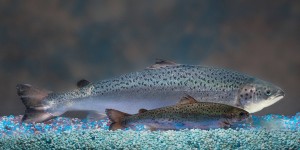 Draft guidelines released by FDA when the salmon was approved do not require retailers to inform consumers that the fish is GE. Instead, the agency provided examples of voluntary statements, such as “genetically engineered,” or “This salmon patty was made from Atlantic salmon produced using modern biotechnology,” that producers  can consider using. The FDA policy makes it virtually impossible for shoppers wishing to avoid the GE fish to make an informed decision at the point of purchase. While most major food retailers, including Trader Joe’s, Aldi, Whole Foods, Kroger, Costco, Safeway, and Giant Eagle have announced they will not stock GE salmon, top retailer Walmart indicated it was too busy with Black Friday to issue a decision.
Draft guidelines released by FDA when the salmon was approved do not require retailers to inform consumers that the fish is GE. Instead, the agency provided examples of voluntary statements, such as “genetically engineered,” or “This salmon patty was made from Atlantic salmon produced using modern biotechnology,” that producers  can consider using. The FDA policy makes it virtually impossible for shoppers wishing to avoid the GE fish to make an informed decision at the point of purchase. While most major food retailers, including Trader Joe’s, Aldi, Whole Foods, Kroger, Costco, Safeway, and Giant Eagle have announced they will not stock GE salmon, top retailer Walmart indicated it was too busy with Black Friday to issue a decision.
In order to avoid the fish at other grocery stores, at this point in time, shoppers can look for country of origin labels as a clue as to whether the salmon is genetically engineered. The salmon will be farm-raised in Panama, so avoiding salmon labeled “farm-raised” or “product of Panama” is a good way to stay avoid the GE product. However, note that processed salmon products, such as pre-packaged salmon burgers, are not subject to the same labeling requirements. Because there is no organic farm-raised salmon, this is a matter where looking for the organic seal will not help consumers avoid a GE food. To assist, the Center for Food Safety has put together a guide to help consumers avoid eating GE fish.
Concerns over labeling are buoyed by the potential for adverse human and environmental impacts resulting from the production of AquAdvantage salmon. Notably, FDA approved the fish under a provision within the Federal Food, Drug, and Cosmetic Act, for “new animal drugs.” Under this clause, FDA considers the growth gene inserted from the eel-like Ocean Pout into the GE salmon to “meet the definition of a drug,” according to the agency’s press release. Further, when applying this provision, companies are not required to disclose application data to the public. While data was disclosed during this process, advocates assert that FDA failed to consider numerous potential adverse impacts, and such a loophole does not bode well for the approval of future GE animals.
FDA asserts that it has determined that approval of the salmon would not significantly impact the environment because of “multiple and redundant measures being taken to contain the fish and prevent escape and establishment in the environment.” Conversely, in acknowledging that escapes can (and do) occur with farm-raised fish, the agency indicates the fish “would be unable to interbreed or establish populations in the wild.” However, a 2012 study from Canadian researchers found that AquAdvantage salmon have the potential to successfully crossbreed with brown trout. The study not only found that GE salmon can crossbreed with brown trout, but also that their GE hybrid offspring could outgrow wild salmon, non-GE hybrid offspring, and even GE salmon. The GE hybrids also out-competed wild salmon and GE salmon in simulated stream environments, further stunting the growth of other fish.
After the decision was announced last month, the Center for Food Safety announced plans to sue FDA in order to stop approval of the AquAdvantage Salmon.
For more information on the human environmental hazards associated with GE technology, and national and local efforts to label GE food, visit Beyond Pesticides’  Genetic Engineering webpage. While the organic seal does not exist for farmed seafood, controversial  regulations are currently in the works. In order to support strong organic standards that provide an alternative to the conventional food market where GE products are not labeled, consumers must participate in the public process surrounding organic production. Visit Beyond Pesticides’ Keeping Organic Strong page for the latest on materials to be evaluated by the National Organic Standards Board. And, visit the Save Our Organic program page to ensure the public trust in the organic label is maintained.
All unattributed positions and opinions in this piece are those of Beyond Pesticides.
Sources: Civil Eats, FDA Press Release
Posted in Announcements, Aquaculture, Contamination, Genetic Engineering, Labeling, Litigation, National Politics, Take Action by: Beyond Pesticides
1 Comment
30
Nov
(Beyond Pesticides, November 30, 2015) Last week, two studies were published that link neonicotinoid (neonic) insecticide exposure to detrimental effects in bees and butterflies. The first study, published in the international scientific journal Nature, found that bumblebees exposed to neonics suffered pollination services impairment that reduces their delivery to apple crops. The second study, published in the United Kingdom journal Peer J, used over 1,000 sites cataloged from 1984 to 2012 in the UK Butterfly Monitoring Scheme (UKBMS) database to point to the strong association between neonic use and butterfly population decline.
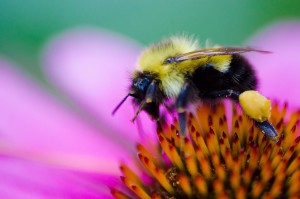 These studies contribute to the mounting evidence that neonic insecticides are linked to pollinator decline. Neonics have increasingly been the subject of recent studies that highlight a causal relationship between neonic exposure  and harmful effects to pollinators, like foraging and reproductive complications. These effects are being identified by scientists all over the world, gradually negating industry criticism of study design.
These studies contribute to the mounting evidence that neonic insecticides are linked to pollinator decline. Neonics have increasingly been the subject of recent studies that highlight a causal relationship between neonic exposure  and harmful effects to pollinators, like foraging and reproductive complications. These effects are being identified by scientists all over the world, gradually negating industry criticism of study design.
Andre Gilburn, PhD, and ecologist at the University of Stirling, led the butterfly study. He said, “Our study not only identifies a worrying link between the use of neonicotinoids and declines in butterflies, but also suggests that the strength of their impact on many species could be huge.” While the  study authors find  that the main cause for butterfly decline is habitat deterioration, they conclude that neonic use is either acting as a proxy for or helping to quantify the agricultural intensification that is contributing to habitat deterioration. They recommend a more intensive look at neonics to determine their widespread toxicity to butterflies.
In other recent studies, glyphosate has been linked to  the  decline of monarch butterflies, whose sole source to lay their eggs, milkweed plants, are being devastated as a result of glyphosate-resistant genetically engineered crops.
University of Guelph professor, Nigel Raine, PhD, who headed the bumblebee study, said, “Until now, research on pesticide effects has been limited to direct effects on bees themselves.” Dr. Raine’s work points to the synergistic effect on bumblebees in field conditions due to neonic exposure. Recently, French scientists addressed  the issue of  inconsistent lab and field conditions  by analyzing reproductive effects in honey bees in field studies. The results show that  harmful effects to individual honey bees can hurt a hive long-term. A study released in October found that neonics severely affect queen bees by decreasing their egg-laying abilities, altering reproductive development and causing death. In February, Scottish scientists discovered that the levels of neonicotinoid (neonic) pesticides bees are likely to encounter in the wild impair the pollinator’s brain cells, resulting in colony declines. The results of recent studies and the newest bumblebee study all point to a threat to the overall sustainability of colonies and long-term effects of neonic insecticides.
Bumblebees are major pollinators of apples and many other important crops around the world. Together with other wild and managed insects their pollination services to crops are valued at close to $500 billion CDN worldwide every year,” said Dr. Raine, pointing to the serious implications of pollinator decline.
While the U.S. Fish and Wildlife Service  banned the use of neonics  on National Wildlife Refuge Land, and the White House Council on Environmental Quality  released new guidelines  prohibiting the planting of neonic-treated plants at federal facilities, EPA and U.S. Department of Agriculture (USDA) have taken little substantive action. Although EPA recently proposed  modest label changes  to protect bees from acute pesticide exposure, USDA submitted comments criticizing the agency’s proposed rule, saying that it had “not established the need for such a prohibition.” In fact, USDA has gone as far as suppressing and targeting its own scientists  who  have linked neonics to bee-toxic effects.
The  Saving America’s Pollinator’s Act of 2015  remains an avenue for Congress to address the pollinator crisis.  Contact your U.S. Representative  and ask them to support this important legislation today. You can also get active in your community to protect bees by advocating for policies that restrict their use. Montgomery County, Maryland recently  restricted the use of a wide range of pesticides, including neonics, on public and private property.  Sign here  if you’d like to see your community do the same!
All unattributed positions and opinions in this piece are those of Beyond Pesticides.
Source: PeerJ, Nature
Posted in Announcements, Chemicals, Habitat Protection, Increased Vulnerability to Diseases from Chemical Exposure, National Politics, neonicotinoids, Persistence, Pesticide Drift, Pesticide Regulation, Pesticide Residues, Pollinators, Take Action, Wildlife/Endangered Sp. by: Beyond Pesticides
No Comments
25
Nov
(Beyond Pesticides, November 25, 2015) In response to a lawsuit filed by environmental groups, the U.S. Environmental Protection Agency (EPA) yesterday revoked the registration of the toxic herbicide “Enlist Duo,” which contains the cancer causing 2,4-D and is central to future uses of genetically engineered (GE) crops in chemical-intensive agriculture. The marketing of this chemical in genetically engineered agriculture has become integral to the chemical industry’s response to weed resistance to the widely used herbicide glyphosate (Roundup), also identified as cancer causing this year by the International Agency for Research on Cancer (IARC).
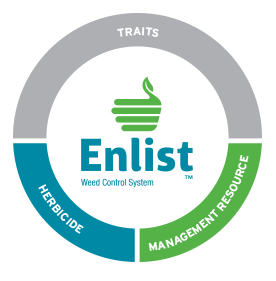 “Instead of looking for genetically engineered silver bullets that result in crop failure, we should be expanding organic agricultural systems that are productive and profitable, protect public health and the environment and slow global climate change,” said Jay Feldman, executive director of Beyond Pesticides.
“Instead of looking for genetically engineered silver bullets that result in crop failure, we should be expanding organic agricultural systems that are productive and profitable, protect public health and the environment and slow global climate change,” said Jay Feldman, executive director of Beyond Pesticides.
Approved by the agency just over a year ago, Enlist Duo is a combination of glyphosate and 2,4-D that Dow AgroSciences developed for use on the next generation of GE crops. EPA stated it is taking this action after realizing that the synergistic effects of the combination of these chemicals is likely significantly more harmful than it had initially believed, and that very small buffer zones it had required are not adequate to protect vegetation.
This action resolves a year-long legal challenge filed by a coalition of conservation groups, including Beyond Pesticides, seeking to rescind the approval of the dangerous herbicide blend, and challenging EPA’s failure to consider the impacts of Enlist Duo on threatened and endangered plants and animals protected under the Endangered Species Act.  EPA had approved use of Enlist Duo in Illinois, Indiana, Iowa, Ohio, South Dakota, Wisconsin, Arkansas, Kansas, Louisiana, Minnesota, Missouri, Mississippi, Nebraska, Oklahoma, and North Dakota, and had intended to approve it in additional areas in the near future.
Enlist Duo has been marketed as a “solution” for the control of glyphosate-resistant weeds brought on by the widespread use of the chemical on glyphosate-tolerant (Roundup Ready) crops over the last decade. These super weeds now infest tens of millions of acres of U.S. farmland. However, independent and USDA scientists predict that the Enlist Duo “crop system” will only foster resistance to 2,4-D in addition to glyphosate, thus continuing the GE crop pesticide treadmill and escalating the cycle of more toxic pesticides in the environment. Additionally, the health effects of both 2,4-D and glyphosate are well documented. 2,4-D has been linked to soft tissue sarcoma, non-Hodgkin’s lymphoma (NHL), neurotoxicity, kidney/liver damage, and harm to the reproductive system. Glyphosate has been recently classified as a human carcinogen  based on laboratory studies by the World Health Organization (WHO) in March.
As the crisis in weed resistance escalates, threatening crop productivity and profitability, advocates point to organic agriculture as a solution that protects public health, the environment, and farmers’ livelihood. By utilizing ecological pest management strategies, organic practices, and solutions that are not chemical-intensive are the most appropriate and long-term solution  to managing unwanted plants, or weeds. Additionally, organic agriculture is an ecologically-based management system that prioritizes cultural, biological, mechanical production practices, and natural inputs. By strengthening on-farm resources, such as soil fertility, pasture and biodiversity, organic farmers can minimize and even avoid the production challenges that most genetically engineered organisms have been falsely-marketed as solving. To learn more about organic agriculture, see  Beyond Pesticides Organic Program Page.
The suit was filed by Earthjustice and Center for Food Safety, on behalf of Center for Food Safety, Beyond Pesticides, Center for Biological Diversity, Environmental Working Group, the National Family Farm Coalition, and Pesticide Action Network North America.
View the decision here.
Download a press release here.
All unattributed positions and opinions in this piece are those of Beyond Pesticides.
Posted in 2,4-D, Alternatives/Organics, Announcements, Cancer, Chemicals, Contamination, Disease/Health Effects, Genetic Engineering, Glyphosate, Litigation, National Politics, non-Hodgkin's Lymphoma by: Beyond Pesticides
No Comments
 Minimum risk pesticides, or  25(b) pesticides, are a special class of pesticides that are not required to be registered with EPA because their ingredients, both active and inert, are considered nonhazardous  to human health or the environment. They include commonly known botanicals and plants compounds such as cedarwood oil, citronella, corn meal gluten, peppermint oil, sodium chloride and white pepper that can be used for their pesticidal properties. Manufactures of these  products are required to fully disclose their ingredient list  on product labels, which Beyond Pesticides has long championed for all pesticide products. Currently, so-called inert ingredients, which EPA considers proprietary information and make up the majority of product ingredients in many pesticides, are not disclosed on pesticide product labels. However, there has been a lack of clarity on minimum risk pesticide product labels in the past that  has made it difficult for enforcement officials to ensure compliance with the 25(b) criteria, given that the manufacturer uses its own judgment on whether the product meets the exemption requirements.
Minimum risk pesticides, or  25(b) pesticides, are a special class of pesticides that are not required to be registered with EPA because their ingredients, both active and inert, are considered nonhazardous  to human health or the environment. They include commonly known botanicals and plants compounds such as cedarwood oil, citronella, corn meal gluten, peppermint oil, sodium chloride and white pepper that can be used for their pesticidal properties. Manufactures of these  products are required to fully disclose their ingredient list  on product labels, which Beyond Pesticides has long championed for all pesticide products. Currently, so-called inert ingredients, which EPA considers proprietary information and make up the majority of product ingredients in many pesticides, are not disclosed on pesticide product labels. However, there has been a lack of clarity on minimum risk pesticide product labels in the past that  has made it difficult for enforcement officials to ensure compliance with the 25(b) criteria, given that the manufacturer uses its own judgment on whether the product meets the exemption requirements.








 In April of last year, Dr. Lundgren published a study in The Science of Nature (
In April of last year, Dr. Lundgren published a study in The Science of Nature ( Intersex occurs when one sex develops characteristics of the opposite sex. In the case of this study, researchers found testicular oocytes ””female eggs found inside male testicles””in male smallmouth and largemouth bass. The
Intersex occurs when one sex develops characteristics of the opposite sex. In the case of this study, researchers found testicular oocytes ””female eggs found inside male testicles””in male smallmouth and largemouth bass. The








 The study, titled
The study, titled 
 Mike Belliveau, executive director of Environmental Health Strategy Center in Maine, in a
Mike Belliveau, executive director of Environmental Health Strategy Center in Maine, in a Following a smallmouth bass (SMB) population crash in 2005, and additional observed maladies, such as tumors and lesions on SMB, the team used ground-breaking monitoring strategies to collect more than 30,000 water quality records annually, along with review of existing research to isolate the possible causes keeping young-of-the-year (YOY) SMB from growing to adulthood. The study provides evidence to what Beyond Pesticides suspected back in May, when PFBC confirmed that a rare malignant tumor was found for the first time on a SMB caught by an angler back in the summer of 2014. Though the findings at the time did not point to a specific cause for the cancer found on the SMB, agricultural pesticides,
Following a smallmouth bass (SMB) population crash in 2005, and additional observed maladies, such as tumors and lesions on SMB, the team used ground-breaking monitoring strategies to collect more than 30,000 water quality records annually, along with review of existing research to isolate the possible causes keeping young-of-the-year (YOY) SMB from growing to adulthood. The study provides evidence to what Beyond Pesticides suspected back in May, when PFBC confirmed that a rare malignant tumor was found for the first time on a SMB caught by an angler back in the summer of 2014. Though the findings at the time did not point to a specific cause for the cancer found on the SMB, agricultural pesticides,  A series of back-and-forth communications between the Oregon Department of Agriculture and Applebee Aviation has resulted in a restraining order, $180,000 in fines, a five-year license revocation, and over 800 acres of state
A series of back-and-forth communications between the Oregon Department of Agriculture and Applebee Aviation has resulted in a restraining order, $180,000 in fines, a five-year license revocation, and over 800 acres of state National Institutes of Food and Agriculture (NIFA) and authorized by the 2014 Farm Bill, will aid farmers and ranchers with whole farm planning by delivering  “practical  research-based information and will improve the ability of growers to develop  organic system plans”  as required for certification under the Organic Foods Production Act (OFPA).  Applications are due March 10, 2016. Please see the”¯
National Institutes of Food and Agriculture (NIFA) and authorized by the 2014 Farm Bill, will aid farmers and ranchers with whole farm planning by delivering  “practical  research-based information and will improve the ability of growers to develop  organic system plans”  as required for certification under the Organic Foods Production Act (OFPA).  Applications are due March 10, 2016. Please see the”¯ the use of neonicotinoids in the  case  of an infestation, however, the permit will no longer be available and citizens will be encouraged to employ alternative practices or products. The ban will also apply to golf courses and properties in the City used for agricultural and horticultural purposes.
the use of neonicotinoids in the  case  of an infestation, however, the permit will no longer be available and citizens will be encouraged to employ alternative practices or products. The ban will also apply to golf courses and properties in the City used for agricultural and horticultural purposes. The Â
The  

 Under the new rules, all growers will be required to undergo this testing, and failure will result in the untested batch being destroyed. This is a change from prior rules which allowed laboratories to determine on their own what pesticides to include in a screening. This change was deemed necessary in light of Â
Under the new rules, all growers will be required to undergo this testing, and failure will result in the untested batch being destroyed. This is a change from prior rules which allowed laboratories to determine on their own what pesticides to include in a screening. This change was deemed necessary in light of  
 The announcement was made at a press conference held in conjunction with the COP21 United Nations Conference on Climate Change, November 30 — December 11, in Paris.
The announcement was made at a press conference held in conjunction with the COP21 United Nations Conference on Climate Change, November 30 — December 11, in Paris.

 Draft guidelines
Draft guidelines


